N.21
Summer 2023
Tutto il blu di Trieste

Summer Time
Sea Food Top 20
Portfolio MiraMare
Club Campus verde electric. Un’idea brillante! Perché a volte abbiamo le idee chiare su ciò che vogliamo, ed è semplicemente un po’ di più: più chiarezza e libertà, più spontaneità e capacità di lasciare il segno. Club Campus è un modello giovanile, robusto e sportivo, resistente all’acqua fino a 10 atm. Al suo interno ticchetta il calibro Alpha, a carica manuale e altamente preciso, sviluppato in-house e fabbricato a Glashütte. Offre qualità e chiarezza a chi vive a fondo ogni momento.
Club Campus verde electric. Un’idea brillante! Perché a volte abbiamo le idee chiare su ciò che vogliamo, ed è semplicemente un po’ di più: più chiarezza e libertà, più spontaneità e capacità di lasciare il segno. Club Campus è un modello giovanile, robusto e sportivo, resistente all’acqua fino a 10 atm. Al suo interno ticchetta il calibro Alpha, a carica manuale e altamente preciso, sviluppato in-house e fabbricato a Glashütte. Offre qualità e chiarezza a chi vive a fondo ogni momento.
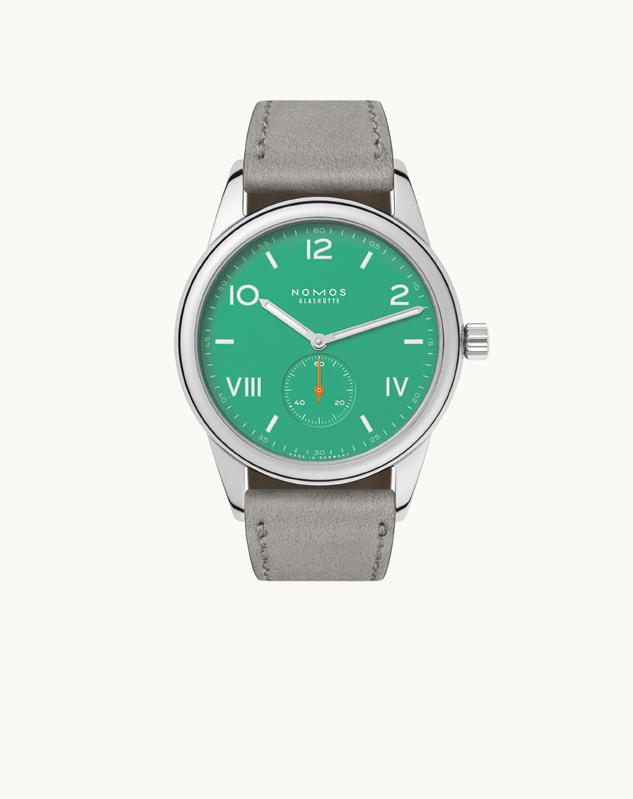

Questo orologio è in vendita anche nella versione cream coral con 36 e 38 millimetri di diametro. Disponibile presso rivenditori selezionati, come orologeria BASTIANI. Per maggiori informazioni: orologeriabastiani.com e nomos-glashuette.com


Via S. Nicolò, 27 . 34121 – Trieste (TS) Tel. +39 040 630942 BASTIANI
www.triestelifestyle.com
direttore responsabile
Giovanni Marzini
coordinamento
Paola De Cassan
segreteria di redazione
Fabiana Parenzan redazione@prandicom.it
Via Cesare Battisti 1, 34125 Trieste
hanno collaborato
Micol Brusaferro, Alice Fabi, Isabella Franco, Nicolò Giraldi, Maddalena Giuffrida, Rino Lombardi, Lorenzo Michelli, Francesca Pitacco, Alberto Polojac, Ilaria Romanzin, Ottavio Silva, Lucija Slavica
marketing advisor
Stefania Boccabianca
illustrazioni
Jan Sedmak
traduzioni
Rita Pecorari Novak, Eugenia Dal Fovo, Rebecca Blakey
progetto grafico e impaginazione
Matteo Bartoli, Elisa Dudine – Basiq
stampa
Riccigraf S.a.s.
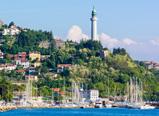
foto di copertina
Fabio Parenzan
fotografie
Giovanni Aiello, Camilla Bach, Pam Carmichael, Carlo Borlenghi, Nicola Brollo, A. Buldrin, Massimo Cettin, Paola De Cassan, Fabio Parenzan, Ilaria Romanzin, Fabrizio Ruzzier, Carlo Spaliviero, Matteo Weber, Mauro Zocchi, Comune di Trieste, Discover Trieste, Archivio Gal Carso, PromoTurismoFVG, Archivio iStock, Archivio Adobe Stock
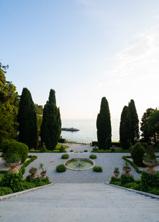
Ies Magazine Trieste Lifestyle N°21 – Summer 2023 Autorizzazione del Tribunale di Trieste del 16 marzo 2018, numero periodico 9/2018 V.G. 847/2018. un progetto
Città da scoprire Discover the city MARE OVUNQUE 6 di Nicolò Giraldi TUTTO IL BLU DI TRIESTE 14 di Francesca Pitacco IL MARE DENTRO LA CITTÀ 20 di Lucija Slavica TOP 20 24 di Rino Lombardi NOTIZIE DALL’ESTERNO 30 di Ottavio Silva UN TUFFO CON FIDO 32 di Ilaria Romanzin Portfolio MIRA MARE 34
di Fabio Parenzan Sommario IES, TRIESTE LIFESTYLE N°21 — Summer 2023
fotografie
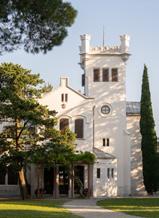

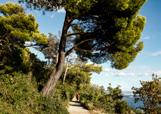
Città da vivere Live the city TRA LE STANZE DEL CASTELLETTO 42 di Isabella Franco PORTO VECCHIO, PORTO VIVO 46 DAVID LACHAPELLE FULMINI 50 di Lorenzo Michelli LA MUSICA DELL’ESTATE 52 di Paola De Cassan ENGEL & VÖLKERS, L’ESPERIENZA AL SERVIZIO DEL BELLO 54 Città da gustare Taste the city FRITTO MISTO! 56 di Alice Fabi CAFFÈ CON VISTA 60 PALMANOVA VILLAGE: TERRA DI STORIA E DI SHOPPING 64 Fuori porta Outside the city MUJA! 66 di Micol Brusaferro ‘AL CASTELLO’ CUCINA DI MARE IN UN POSTO FAMILIARE 70 SENTIERI DI MARE E DI PIETRA 72 di Maddalena Giuffrida IL SORRISO AL CENTRO 76 UNA RICCA ESTATE NEL SITO UNESCO IMMERSO TRA NATURA E STORIA 78 IN RIFUGIO C’È PIÙ GUSTO 80 IMMERGERSI IN UN MARE DI VERDE 84 Sommario IES, TRIESTE LIFESTYLE N°21 — Summer 2023
 di /by Giovanni Marzini
di /by Giovanni Marzini
Cosa significa essere una città di mare? Non certo (e non solo) affacciarsi su un golfo, circondati da spiagge ed arenili affollati di bagnanti sotto l’ombrellone. Partiamo allora proprio da qui, da quello che Trieste non è: tutto questo. Eppure è una città di mare. Perché il mare lo vede, lo respira, soltanto se vuole lo tocca. Perché il mare ce l’ha dentro. L’estate di IES vuole suggerirvi allora come vivere il nostro mare alla “triestina”. Potrà esserci il piacere (ma non l’obbligo) di un tuffo in quell’enorme piscina senza onde che è questo estremo nord di Adriatico; ma ci sarà anche la sensazione di vivere il mare solo osservandolo, annusandolo, sfiorandolo o ammirandolo da un bastione carsico a picco sull’azzurro di un’acqua capace di agitarsi solo nelle giornate di bora.
Sfogliando queste pagine scoprirete allora come la città entri a volte con prepotenza dentro il suo mare e come per contro l’acqua salata bagni suolo e sottosuolo di questo antico borgo cresciuto nei secoli tenendosi stretto la complicità del mare.
Troverete il mare dopo il tramonto nelle luci blu che in piazza dell’Unità vi ricordano sin dove arrivava un tempo, lo ritroverete in quella che è la passione di una delle città più sportive d’Italia che lo vive praticando una miriade di discipline galleggianti. Lo incontrerete la sera sul piatto di una cucina che vi consiglierà di andare oltre gli scontati menù estivi, per guidarvi invece alla scoperta di suggestive proposte grazie ad un pesce ingiustamente definito “povero”.
Ma se proprio vorrete fare “splash” nel blu di Trieste, vi consigliamo una sveglia di buon’ora, una corsa o una passeggiata da Barcola verso Grignano ed un tuffo dove scorgerete l’acqua più limpida, in quello che è il più grande e totalmente gratuito stabilimento balneare della città. Non servono troppe indicazioni. Lo troverete facilmente e capirete perché per i triestini c’è il mare lì fuori, ma soprattutto c’è un… mare dentro. Il loro cuore.
IL MARE DENTRO THE SEA WITHIN
What does it mean to be a seaside city? It certainly cannot (only) be about having a seafront on the Gulf, outlined by beaches and sandy shores crowded with bathers and beach umbrellas. Because this is precisely what Trieste is not. And yet, Trieste is an undisputed seaside city: she overlooks, breathes, and touches the sea. She has the sea within.
IES’ summer issue provides a few tips on how to enjoy the sea à la Triestina. Of course, one may experience “our” sea the traditional way: taking a dip into this huge waveless pool in the northernmost corner of the Adriatic Sea. Or one may wish to try something new: experiencing the sea by looking at it, smelling its scent, skimming its surface, or embracing it with one’s gaze from the top of a Karst cliff – a breath-taking view of still blue waters that only the Bora wind can stir.
Leafing through these pages you will find out about the ways in which the city sometimes forces her way into her sea, and, conversely, saltwater soaks the ground and substratum, upon which this ancient hamlet was built and evolved throughout the centuries, never letting go of her faithful companion, the sea.
You shall see the sea of Piazza dell’Unità, whose blue lights shine as a reminder of how far inland the Gulf waters used to reach; you shall find it in the passion of one of Italy’s most sport-loving cities, where countless sport endeavours revolve around water; and you shall meet it again at dinner, as you taste one of Trieste’s traditional recipes – those you can only find when you avoid clichéd summer menus, focusing, instead, on the rich and diversified choice offered by local seafood cuisine, commonly (and, perhaps, unfairly) known as “peasant”.
And if you are still longing for a dive into the blue, here is our tip: wake up early, go for a run or a stroll along the stretch of coast extending from Barcola to Grignano, find the spot where the water is at its clearest and most inviting, and dive – after all, this coastline has been the largest free bathing establishment in the city. No further instructions needed. The sea is easy to find. And when you arrive, you shall know why Triestini live their sea out there… but mostly within their heart.
5 IES, TRIESTE LIFESTYLE N°21 — Summer 2023 Editoriale
Nicolò Giraldi
Sedmak
Più di un golfo, tanti orizzonti diversi dentro alla città
More than one gulf, many different views inside the city
Mare ovunque
Sea everywhere

di /by
6 IES, TRIESTE LIFESTYLE N°21 — Summer 2023 Città da scoprire
illustrazione di /illustration by Jan
ATrieste si è portati ad immaginare il mare alla stregua di una massa galleggiante dove proiettare personali ambizioni e storie di comunità sembra facile. La direzione, abusata nella sua banalità, è quella di una città che vive una relazione privilegiata con i mari che la bagnano: Trieste è adriatica, eppure così mediterranea, potremmo affermare.
Il modello narrativo, non è difficile interpretarlo, sconta un approccio che impone la città, e non viceversa. Trieste deve la sua fortuna a ciò che qui viene trasportato via mare, non grazie al mare. Dopo l’attracco delle imbarcazioni sulle rive, o sulle sponde del Canal grande fino a ridosso della chiesa intitolata a Sant’Antonio, le merci venivano scaricate per poi prendere una direzione precisa, vale a dire il mercato cittadino. Quando arriva la ferrovia, tempo dopo, le merci viaggiano verso

7 IES, TRIESTE LIFESTYLE N°21 — Summer 2023 Discover the city

8 IES, TRIESTE LIFESTYLE N°21 — Summer 2023 Città da scoprire
l’entroterra dell’Europa centrorientale senza fermarsi. Per capire ciò che rimane a Trieste e ribaltare così la geografia della narrazione, bisogna addentrarsi in quella che è la prima (o la seconda) periferia triestina. È da lì, camminando a mezza costa senza mai perdere di vista l’Adriatico, che si può nuotare nel mare interno di questa città.
Come racconta Fernand Braudel ne “Il Mediterraneo”, molti dei generi alimentari che ancora oggi fanno parte della nostra cucina provengono da altri mondi. Così, al viaggiatore susciterà una certa curiosità sapere che in alcuni paesi del Carso, subito oltre la linea dell’altopiano, i pomodori non si mangiavano –né si coltivavano– fino ad inizio Novecento; fu il mare, molti secoli prima, a farli giungere fino in Europa. Questa città non è riuscita a cambiare il mare –forse solo la Repubblica di Venezia e la marina britannica ce l’han fatta–, è il mare che ha cambiato il corso della sua storia.
Da ogni balcone naturale, sia esso pastino o vedetta, a Trieste si vede il mare. A mezza costa –dicevamo– si snodano sentieri e strade che corrono verso ogni dove. Alcune portano nomi di illustri concittadini. Altre, come strada del Friuli o via dell’Istria, conducono nei luoghi alle quali sono intitolate. Via Revoltella è una lunghissima arteria dedicata al barone Pasquale Revoltella e che collega il centro alla periferia. Nel XIX secolo fu lui a sottoscrivere, per nome e per conto dell’Impero asburgico, la compravendita di parte delle azioni della società che, di lì a poco, avrebbe “tagliato” l’istmo di Suez, favorendo così i traffici occidentali. La via è lunga
ed in salita: il viaggio verso oriente non era né facile, né scontato.
Ci sono itinerari che venivano percorsi dai pescatori dei paesi del Carso. Ancora oggi lunghe scalinate portano al mare e viceversa, in quelle mulattiere tanto adriatiche quanto umane. I nomi si ripetono, tra la riva e il ciglione carsico. Bovedo, nel rione di Barcola, dà il nome tanto ad un torrente quanto ad un bosco di straordinaria bellezza. Un tempo zona di saline e di torrenti, la zona del centro denominata piazza San Giovanni deve il suo nome al ritrovo dei triestini da dove incamminarsi per raggiungere l’omonimo rione, in occasione della festa estiva in suo onore. La direzione è sempre quella, dal mare verso l’entroterra, da ovest verso est. Trieste possiede mari diversi e la corrente giusta non sempre è quella che seguono tutti.
La val Rosandra, con il suo torrente e le sue pozze gelate, è mare interno e refrigerio estivo. Dentro alla riserva naturale ci si può concedere qualche tuffo, quando la canicola estiva è particolarmente insostenibile. Il “mare dentro” potrebbe essere anche un lago, ma a Trieste non ce ne sono. Ci sono i torrenti –chiamati patok, alla slovena-, ma seguirli dalla foce alla sorgente oggi è operazione ardua. Risalendo verso il bosco al Cacciatore il torrente Starebrech (o Farneto, all’italiana) corre vicino al sentiero Bacarubra. Non è Adriatico, ma il profumo del mare, certe sere, si sente fin qua.
Camminando tra il mare e il Carso si può pensare agli arrivi e alle partenze, ai successi quanto ai fallimenti. Quando finisce la Prima guerra mondiale è dal mare che arriva l’esercito italiano, non

La val Rosandra, con il suo torrente e le sue pozze gelate, è mare interno e refrigerio estivo.
Val Rosandra, with its river and icy waterholes, is an inner sea – and a relief from the heat.
Il
in
Faro della Vittoria La cascata
val Rosandra
9 IES, TRIESTE LIFESTYLE N°21 — Summer 2023 Discover the city
G. Aiello
da terra; l’esperimento dell’elica di Ressel è un flop, e la casa d’Austria si lascia scappare la formalizzazione del brevetto dagli inglesi, loro sì, gente di mare. Massimiliano d’Asburgo si innamora di Miramare perché costretto a riparare nella baia di Grignano da un improvviso fortunale, non perché fosse così impellente il bisogno di edificare un castello in onore della sua Carlotta. Dal ciglione ci sono alcuni luoghi da dove ammirare i tramonti. Sono calcari marini, scogli da dove planare sulla città. Può essere un’osmiza in via Commerciale o la rosa dei venti di Conconello; ma sono anche vedette, come quella che sorge nella zona di Duino ed intitolata a Tiziana Weiss, tra le prime alpiniste al mondo a raggiungere un sesto grado da capocordata. Morta dopo un incidente sulle pale di San Martino, Tiziana Weiss è oggi sepolta nel cimitero di Barcola, sulla riviera triestina. A Trieste, dove il mare ha uno spazio tutto suo all’interno delle coscienze, non è raro accostare l’Adriatico alle Alpi, e viceversa. È perché qui le cose possiedono molti nomi e diversi significati, e funzionano –o hanno funzionato– anche quando gli uomini pensavano il contrario. Il mare di Trieste –interno o no– provoca confusione e si agita, ma sa chiarire le imprecisioni ed è in grado di calmare gli spiriti. A volte può suscitare gelosie ed invide, altre volte, invece, è taumaturgico. È dappertutto, basta solo saperlo cercare.
When you live in Trieste, it is only too easy to give in to the cliché of the sea as a mere floating mirror, reflecting personal ambitions and vicissitudes of peoples. A city and her sea(s): Trieste is a true Adriatic port, and yet she has such a Mediterranean soul, it is said. Such timeworn drivel.
This kind of forced narrative, as you may suspect, revolves exclusively around the city. Trieste owes her fortune to the goods carried via sea – and not to the sea itself. Each freight would arrive at the docks, either on the Rive or along the Canal Grande, reach the Temple of Sant’Antonio, and, after the necessary unloading operations, it would invariably head towards the only possible destination, namely the city market. Later on, with the advent of the railroad, goods would skip the city stop entirely and travel directly towards the inland of Central and Eastern Europe. Only by turning this narrative around can we truly understand what was left in Trieste. To do so, we must turn to the immediate (and secondary) outskirts of Trieste, and then walk halfway along the coastline, with the Adriatic Sea always in sight. Only then will we

ENGLISH TEXT
Trieste è adriatica, eppure così mediterranea, potremmo affermare.
Trieste is a true Adriatic port, and yet she has such a Mediterranean soul, it is said.
G. Aiello 10 IES, TRIESTE LIFESTYLE N°21 — Summer 2023 Città da scoprire
Vedetta Tiziana Weiss
LASCIATI ISPIRARE, A GRADO
È il momento di ritrovare te stesso, affondare i piedi nel bagnasciuga, farti cullare dal ritmo lento della laguna e lasciare una parte di cuore sotto il sole, l’altra nei tramonti in riva al mare. È il momento di lasciarti andare a Grado. Io ti sto aspettando, io sono Friuli Venezia Giulia Info: 800 016 044 / info@promoturismo.fvg.it
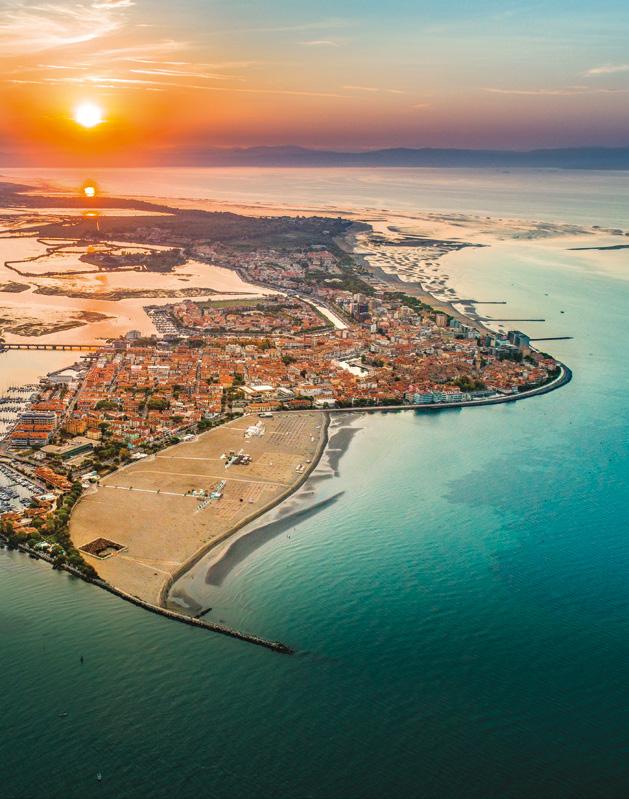
GRADO IO SONO FRIULI VENEZIA GIULIA www.grado.it
Foto: F. Papalettera
Inquadra il QR Code e prenota ora la tua vacanza!
Il mare è dappertutto: basta solo saperlo cercare.
be swimming in the sea within the city.
In his La Méditerranée French historian Fernand Braudel observes that numerous food types considered part of the Mediterranean diet come from different worlds. For instance, you may be surprised to learn that tomatoes were unknown in certain areas at the edge of the Karst Plateau up until the early 20th century −although the first tomatoes had crossed the sea and reached these shores a few centuries earlier. Trieste was never able to change the sea– the Republic of Venice and the Royal Navy may have very well been the only ones to ever succeed in such endeavour. It was the sea that changed the course of the city’s history.
Every natural terrace, be it a stretch of ploughed land or a lookout spot, has a view of the sea. Halfway between coast and inland, an intricated web of roads and paths extends in every direction. Some are named after distinguished Italian citizens. Others, like Strada del Friuli or Via dell’Istria, are named after their destination. Via Revoltella, a long arterial road connecting the city centre to the suburbs, is dedicated to the memory of Baron Pasquale Revoltella, who, in the 19th century, on behalf of the Hapsburg Empire, purchased a number of shares in the company that would soon “pierce” the isthmus of Suez, thus favouring trade exchanges with the western world. It was a long, uphill journey: travelling East had never been an easy or predictable task.
There are itineraries following the routes of Karst fishermen: long stairways that served as Adriatic (and human) cart tracks still connect the Plateau to the sea today. There are names that appear more than once between the Karst shoulder and the coast: Bovedo, in the rione of Barcola, is the name of both a stream and a beautiful forest. Once known for its saltworks and brooks, the city-centre area called Piazza San Giovanni owes its name to the fact that Triestini used to gather here before setting off for the rione of the same name, where celebrations in honour of this Saint are held every summer. Once again, we move from sea to inland, from west to east. Trieste has many seas, and the right current is not always the one following the flow.
Val Rosandra, with its river and icy waterholes, is an inner sea – and a relief
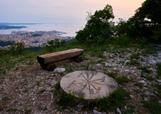
from the heat. Inside the natural reserve a dip in the water is allowed, if the heat is unbearable. The “sea within” could also refer to a lake – but there are no lakes in Trieste. There are rivers and streams –known as patok, Slovenian for “brook”– although it would be quite hard to follow their course from spring to mouth today. Walking through the woods of al Cacciatore, the Bacaruba trail runs upstream alongside the river Starebrech (known today as Farneto). It is no Adriatic, but there are nights when the scent of the sea reaches all the way up here.
Walking between the Karst and sea, the mind may recall departures and arrivals, failures and successes. At the end of the Great War, it was via sea, not land, that the Italian army entered Trieste. Ressel’s first tests on ship propellers were a fiasco, and so the Austrian Empire let the patent slip through their fingers and into the hands of the British, who really knew a thing or two about seafaring. Maximilian of Hapsburg fell in love with Miramare almost by chance, as he made landfall in the bay of Grignano to find shelter from a sudden storm – and certainly not because he was driven by the urgent need to build a castle for his Charlotte. The Karst riff offers a few incomparable views of the sunset. Sea stacks of marine limestone right above the city skyline, as the crow flies. It could be an osmiza in Via Commerciale, or the wind rose in Conconello; or a natural outlook point, like the one in Duino that was named after Tiziana Weiss, among the first women mountaineers to lead-climb an ascent of a 6-grade route. She died after a fall while ascending a route of the Pala group, the largest massif of the Dolomites. Today, Weiss rests in the little cemetery of Barcola, on the seafront. In Trieste, where the sea dwells within one’s very conscience, the Adriatic is often compared to the Alps, and vice versa. Possibly because here things have many names and different meanings, and they work –or at least used to work– even when people did not think so. The sea of Trieste –within or without– stirs and bewilders, but is also able to clarify inaccuracies and soothe the soul. It may spark envy, and it may heal the heart. It is everywhere – one only needs to know where to look.
The sea is everywhere –one only needs to know where to look.
Rosa dei venti a Conconello
12 IES, TRIESTE LIFESTYLE N°21 — Summer 2023 Città da scoprire
G. Aiello


di /by Francesca Pitacco 14 IES, TRIESTE LIFESTYLE N°21 — Summer 2023 Città da scoprire
Tutto il blu di Trieste
All the blue of Trieste
Trieste non ha solo una “scontrosa grazia”, ma anche un modo tutto suo di vivere il mare.
Per la maggior parte delle persone che arrivano a Trieste il primo impatto non è con la città, con la sua architettura neoclassica o le sue piazze ariose, bensì con il suo mare. C’è chi raggiunge Trieste dalla Costiera, chi la coglie alle spalle dal Carso, chi la approccia faccia a faccia con una nave da crociera. Trieste è una città di mare o con il mare?
Difficile dare una risposta, se non che il mare sta veramente sia dentro Trieste, sia dentro i triestini, nella sua storia più nobile e nella loro quotidianità più spicciola.
Difficile trovare un’altra città di simili dimensioni che conceda una fruizione così completa del mare dal suo centro. Piazza Unità e il Molo Audace infondo sono un tutt’uno, legati intimamente dai passi di chi vuole passare dal caldo abbraccio della piazza monumentale alla promenade protesa verso gli spazi aperti del golfo, dove i pensieri si distendono e polmoni e cuore
si riempiono del salmastro dell’ultimo lembo del Mediterraneo.
Questo è il primo modo per godersi il mare nel capoluogo giuliano: percorrere a piedi Rive e moli, osservarli nelle diverse ore del giorno e nelle attività che ancora possono offrire. Per un concerto o una sessione di yoga all’alba o al tramonto bisogna controllare il programma di Triestestate (www. triestestate.it) o fare un salto all’infopoint di Via dell’Orologio; ancora più semplice veder manovrare una nave da crociera, visto il flusso sempre più cospicuo di questi giganti del mare nell’alto Adriatico. È tuttavia la Sacchetta –la parte finale delle Rive– il luogo dove si comprende il rapporto intimo e verace dei locali con il mare: canoa, canottaggio, vela non sono sport, sono discipline di vita. Impossibile infatti dimenticare che Trieste diventa la seconda domenica di ottobre la capitale mondiale della vela grazie alla Barcolana, la regata più affollata al mondo con almeno 1.500 barche
Trieste has her unique “surly grace”, but also her own unique way of living the sea.
. 15 IES, TRIESTE LIFESTYLE N°21 — Summer 2023 Discover the city
Triestina della Vela
La Triestina della Vela, storico club velico cittadino che ha sede nella Sacchetta, celebra quest'anno il suo centenario con un ricco programma di eventi sportivi e culturali. Fra tutti segnaliamo la mostra La collezione Carlo Sciarrelli che si terrà nella sala Leonor Fini del Magazzino 26 dall'8 novembre all'11 dicembre 2023.
Per la prima volta sarà esposta al pubblico la collezione privata di Carlo Sciarrelli, ora custodita nel Fondo dell’Archivio Storico della Modiano. Si potranno ammirare oltre ai mezzi modelli, e alcuni modellini delle sue barche, la collezione di ship portreits raccolta in più di 40 anni, che rappresenta un unicum, per la qualità degli autori, la varietà dei soggetti.

The Triestina della Vela, the historic city sailing club based in the Sacchetta harbour area, celebrates its centenary this year with a rich programme of sporting and cultural events. Among them, we would like to point out the exhibition ‘The Carlo Sciarrelli Collection’, which will be held in the Leonor Fini room of Magazzino 26 from 8 November to 11 December 2023. For the first time, Carlo Sciarrelli’s private collection, now kept in the Modiano Historical Archive Fund, will be on public display. In addition to the half-models, and some models of his boats, you will be able to admire the collection of ship portraits collected over more than 40 years, a unique exhibition in terms of the quality of the authors and the variety of subjects.

a vela tutte assiepate sulla medesima linea di partenza posizionata idealmente tra il Faro della Vittoria e il Castello di Miramare. Una gara agonistica per pochi. Una festa del mare per tutti.
Per chi non vuole solo stare a guardare, il mare a Trieste si può vivere in molti modi. Sebbene la costa non offra spiagge di sabbia piccoli stabilimenti e aree libere punteggiano il litorale che va da Muggia a Sistiana. Il più celebre dei “bagni” storici è senza ombra di dubbio Alla Lanterna, meglio noto come Pedocin [1], posizionato all’ombra dell’antico faro della città e noto per dividere con un muro gli uomini (a destra) e le donne (a sinistra). Poco distante l’Ausonia [2], nato in epoca fascista, è consigliato a chi ama prendere il sole sulle terrazze e tuffarsi dalle piattaforme nella piscina di acqua salata. Qui si svolge annualmente una goliardica gara di “clanfe”, il tipico tuffo dei muli –i ragazzi– di Trieste, che comincia come un tuffo a testa per poi portare il corpo in una posizione raccolta a ferro di cavallo (la clanfa, appunto) per produrre il massimo degli schizzi e degli spruzzi.
Uscendo dal centro verso Barcola [3], ossia il cuore della balneazione locale, non si potrà trattenere lo stupore davanti alla fruizione del lungomare da parte
di residenti e turisti tutti assiepati a contendersi un lembo di strada per distendere il proprio telo o aprire la sdraio. Che sia per un’ora o per tutto il giorno qui si passerà senza soluzione di continuità dal crogiolarsi al sole, al tuffo, alla nuotata, approfittando magari del noleggio di pattini e barche a vela di piccolissime dimensioni ubicato alla fine della pineta. Maggior comfort si potrà trovare ai lati del promontorio di Grignano, dominato dal Castello di Miramare, dove Sticco [4] e gli stabilimenti di Grignano [5] ,offrono spogliatoi, capanni, lettini e docce. L’Area Marina Protetta di Miramare, che dagli anni Ottanta tutela in maniera integrale lo spazio acqueo antistante il Castello, propone attività di sea watching, immersioni subacquee e campi estivi per ragazzi per chi ama coniugare il turismo attivo alla conoscenza e alla salvaguardia del pianeta blu (tutte le informazioni su www.ampmiramare.it).
Per scoprire la Costiera è bello avventurarsi lungo i sentieri che scendono a picco verso il mare, dove si trovano piccole spiagge di sassi, microscopici approdi, qualche raro ristorantino. Se la discesa –ma soprattutto la salita per recuperare l’auto o raggiungere la fermata del bus– mettono un po’ d’ansia, meglio optare per la baia di Sistiana [8] che propone soluzioni per tutti i gusti e tutte le tasche, dalla spiaggia libera al beach club del modaiolo Portopiccolo [9]. Siete senza auto? Niente paura! Le linee marittime del Delfino Verde collegano il centro città a Muggia, Barcola, Grignano e Sistiana (gli orari sono consultabili su www.delfinoverde.it). Perché anche se non si desidera raggiungere la spiaggia la vista di Trieste dal mare vale il viaggio.
–
16 IES, TRIESTE LIFESTYLE N°21 — Summer 2023 Città da scoprire
La sede della Triestina della Vela
Most visitors are welcomed to Trieste not by the city herself, her neoclassical architecture, or her vast squares: they are welcomed by the sea. Some reach the city following the coastline on the Costiera road; some approach her from above, moving downhill from the Karst; and some others meet her face to face, on deck of a cruise ship making landfall in the Gulf. Trieste: a seaside city or a city with a seaside? There is no easy answer, but one thing is certain: the sea lies within Trieste and her citizens, ever present in her most glorious past and the most inconsequential aspects of their daily routine.

There are not many cities the size of Trieste offering such complete access to the sea from their centre. Piazza Unità and Molo Audace are almost one single space, connected as they are by the steps of those who move from the warm embrace of this monumental square to the promenade that reaches into the Gulf and the open sea, where the mind stretches, while heart and lungs breathe in the salty air of this northernmost corner of the Mediterranean.
This is the most immediate way of experiencing the sea of Trieste: taking a stroll along the Rive and its piers, observing them at different times of day, or enjoying the numerous activities they offer. You may wish to take a look at the programme of Triestestate (www.triestestate.it) or visit the Infopoint in Via dell’Orologio to find out about concerts and yoga lessons at sunrise or sunset; or you may simply stop and take in the sight of a huge cruise ship during her steering operations – they are increasingly easier to spot, now that more and more of them sail on the northern Adriatic routes. However, the Sacchetta (lit. little pouch), namely the final portion of the Rive, remains the best spot to learn about the deep connection between the sea and the Triestini: rowing, kayaking, sailing – more than sports, they are life disciplines. It is not surprising, therefore, that every year, on the second Sunday of October, Trieste becomes the world’s capital of sailing thanks to Barcolana, the world’s greatest regatta in terms of

ENGLISH TEXT
Il Molo Audace, il Pedocin e la Barcolana sono le icone del mare di Trieste.
Molo Audace, Pedocin, and Barcolana are the symbols of Trieste’s sea.
C. Borlenghi
17 IES, TRIESTE LIFESTYLE N°21 — Summer 2023 Discover the city
M. Cettin
participation: more than 1,500 vessels crowding the starting line – an imaginary thread hanging between the lighthouse Faro della Vittoria and Castello di Miramare. A competitive race for a select few. A sea celebration for all.

Experiencing the sea of Trieste is not just about sitting and watching. True, you will not find sandy beaches around here, but the whole seaboard from Muggia to Sistiana is dotted with countless small bathing establishments and free-access areas. The most famous “bagno” (local vernacular for bathing establishment N/T) is the legendary “Alla Lanterna”, better known as “Pedocin” [1]: this narrow inlet of pebbled shore at the foot of the old lighthouse is divided by a wall separating the men’s side (right) from the women’s side (left). The nearby “Ausonia” [2] bathing establishment dates back to Italy’s fascist period; it is the perfect spot to sunbathe on one of its terraces or to dive from the platforms hanging over the pool of saltwater. Every year Ausonia hosts a mock diving match called Clanfe Olympics, owing their name to an unofficial diving technique invented by the muli (i.e., youth) of Trieste: it starts as a regular head-first dive with a short run up, until the diver rolls into position mid-air, and eventually hits the water almost resembling a horseshoe (the Triestine dialect term “clanfa” comes from the non-standard German word “Klampfe”, sometimes used to indicate “horseshoe”, N/T). The greater the splash, the higher the score.
Immediately outside the city centre, heading towards Barcola [3] (the real heart of the city’s seaside life), an unusual sight unfolds: locals and tourists setting up their sunbeds and stretching their
towels to cover every inch of the narrow stretch of concrete separating the road from the sea. Here you can spend one hour or an entire day sunbathing, diving, and swimming. Paddle boats and tiny sail boats are available for rental at the far end of the pine grove.
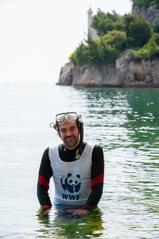
Bathers looking for a more comfortable arrangement may want to drive on, to the foot of the cape of Grignano [5], under Castello di Miramare, where Sticco [4] and other bathing establishments offer changing rooms, beach cabins, sunbeds, and showers. Miramare’s Marine Protected Area has been in charge of safeguarding the inshore waters in front of the castle since the 1980s. The Area offers numerous guided activities, such as sea watching, scuba diving, and summer camps for young guests, who value active tourism just as much as environmental protection (more at www.ampmiramare.it).
The seaboard is a whole universe that visitors can explore by following the trails that plunge downhill from the Plateau, revealing otherwise invisible pebbled shores, tiny inlets, and the odd greasy spoon. If the descent – or the way back uphill to reach your car or the bus stop – seems too intimidating, the bay of Sistiana [8] may be a better choice: here there is a wide range of options to suit every taste and pocket, from free-access shores to trendy beach clubs, like the one in Portopiccolo [9]
No car? No problem! Delfino Verde motorboats connect the city centre to Muggia, Barcola, Grignano, and Sistiana (routes and timetables available at www. delfinoverde.it). Even if the beach is not your destination, the view of Trieste from the sea is worth the trip.
G. Aiello F. Parenzan 18 IES, TRIESTE LIFESTYLE N°21 — Summer 2023 Città da scoprire
Portopiccolo a Sistiana A destra, Pierpaolo de Flego, sub del WWF
Raggiungere Muggia, Barcola, Grignano e Sistiana via mare è un’alternativa fresca ed ecologica all’uso della macchina.
Sea connections to Muggia, Barcola, Grignano, and Sistiana are a refreshing and eco-friendly alternative to cars.
Baia di Sistiana Sticco Topolini Pineta di Barcola Pedocìn Ausonia Acquario Punta Sottile Porto San Rocco Trieste Muggia Duino Opicina Contovello Prosecco Aurisina Sistiana Barcola Santa Croce 3 4 8 1 3 2 L i nea Trieste-Barcola-Grignano–Sistiana TaeniLtseir e –M u g ig a Grignano 1 e 2 Canovella degli Zoppoli Spiaggia dei Filtri FKK 5 Portopiccolo 9 7 6 10 11 12
19 IES, TRIESTE LIFESTYLE N°21 — Summer 2023 Discover the city
Il mare dentro la città
Chi vive a Trieste non potrebbe mai fare a meno di quello specchio blu che cambia colore assieme al cielo. La connessione tra la città e il mare è talmente forte che la si può ritrovare anche sulla terraferma. Monumenti, strade e piazze nascondono tracce della sua storia e quel legame indissolubile che la caratterizza. Ecco un itinerario per scoprire dettagli, curiosità e chicche del “mare dentro” l’area urbana.
Cominciamo dalla maestosa piazza Unità. Un tempo questa piazza era molto più piccola di quanto lo sia oggi: fino al 1863, quando era conosciuta come piazza San Pietro o piazza Grande, la sua dimensione era dimezzata per la presenza di un mandracchio che ospitava battelli da pesca e altre imbarcazioni. Le lucette blu, che illuminano la pavimentazione della piazza, sono state installate appositamente per indicare fino a dove arrivava il mare.
Poco distante dalla colonna di luce si erge il palazzo del Lloyd Triestino, che oggi ospita gli uffici della Regione del Friuli Venezia Giulia. Questo splendido edificio, progettato dall’architetto Heinrich Von Ferstel tra il 1880 e il 1883, incarna l’eleganza e l’importanza storica legate al mare. Ai piedi della facciata che guarda piazza Unità, sono state collocate due fontane: rappresentano le figure allegoriche di Teti, simbolo dell’acqua dolce, e Venere, simbolo dell’acqua salata.
Andando verso il Municipio, vi imbatterete nella statua dell’Imperatore Carlo VI d’Asburgo, situata di fronte al palazzo Pitteri. Guardandola attentamente noterete che la mano
dell’Imperatore punta verso il mare, mentre il suo sguardo si rivolge a piazza della Borsa, il centro dell’attività economica di quel tempo. E proprio in piazza della Borsa, troviamo la Fontana del Nettuno, dio del mare, opera realizzata dall’architetto bergamasco Giovanni Mazzoleni nel 1750. Anticamente fu uno degli sbocchi dell’acquedotto di San Giovanni, voluto da Maria Teresa d’Austria.
Proseguendo il nostro itinerario, incontriamo il Canal Grande. Questo suggestivo canale, progettato dal veneziano Matteo Pirona tra il 1754 e il 1756, rappresentava una via d’accesso al cuore della città per le imbarcazioni. Originariamente, infatti, le acque del canale arrivavano fino all’attuale Chiesa di Sant’Antonio, ma nel 1934 l’ultima porzione fu interrata utilizzando le macerie provenienti dalla demolizione della città vecchia.
Il nostro viaggio nel mare dentro Trieste si conclude con una vera e propria chicca: le pescherie triestine. La loro peculiarità sta nelle vetrine, sulle quali compaiono ogni giorno giochi di parole e frasi divertenti composte con le varie tipologie di pesci presenti nel golfo. Un esempio? La Pescheria Davide in piazza Garibaldi, che regala ai clienti una interpretazione tutta sua dei film celebri come “Il tempo delle chele” e Polp Metal Jacket”. Esplorando le strade di Trieste, capirete che il legame con il mare è presente ovunque: nelle persone, nelle vecchie osterie e buffet e nelle piccole realtà che ogni giorno regalano alla città un po’ di sano morbin
Tra terra e mare, viaggio nel cuore blu della città
Between land and sea, a journey in the blue heart of Trieste
di /by Lucija Slavica 20 IES, TRIESTE LIFESTYLE N°21 — Summer 2023 Città da scoprire
The sea within the city

21 IES, TRIESTE LIFESTYLE N°21 — Summer 2023 Discover the city
If you live in Trieste, you cannot imagine life without that blue mirror that takes on a new shade every time the sky changes its colour. The bond between the city and her sea is so strong, that it emerges clearly even on dry land. Landmarks, streets, and city squares reveal traces of its history and nature. In the following paragraphs our readers will find an itinerary through the various aspects, fun facts, and titbits of the “sea within” the urban fabric of Trieste.
Let us begin with majestic Piazza Unità. First of all, it was not always as large as it is today: up until 1863, when it was still known as Piazza San Pietro or Piazza Grande, it was half today’s size, because the other half used to host a mandracchio for the mooring
of fishing boats and other vessels. The blue lights dotting the pavement today indicate how far the sea used to reach into the city.
Not far from the line of blue lights the building once owned by major shipping company Lloyd Triestino today hosts the seat of the regional administration Regione del Friuli Venezia Giulia: designed by architect Heinrich Von Ferstel between 1880 and 1883, this magnificent edifice embodies both elegance and historical meaning of the sea. At the foot of its façade on Piazza Unità two fountains represent two allegoric figures: Thetis, nymph, and goddess of freshwater; and Venus, symbolising saltwater.
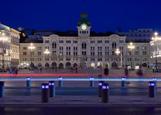
Moving towards City Hall, you will meet the statue of Emperor Charles VI of Hapsburg, standing in front of Palazzo Pitteri. Look closely and you will notice that the Emperor’s raised hand points towards the sea, while his gaze is fixed on Piazza della Borsa, then the very heart of the city’s bustling economic scene. Piazza della Borsa is also where Fontana del Nettuno is found: designed by Bergamo-born architect Giovanni Mazzoleni in 1759, this fountain is dedicated to Neptune, god of freshwater and the sea, and, for a time, it used to be one of the outlets of San Giovanni aqueduct, built under the rule of Empress Maria Theresa of Austria.
The next stop in our itinerary is Canal Grande. Designed by Venice-born architect Matteo Pirona between 1754 and 1756, this picturesque canal was the watercrafts’ entry way into the city centre. Indeed, Canal Grande used to reach all the way to the Church of Sant’Antonio; in 1934, however, the last stretch of water was filled up with the debris resulting from the demolition of the old town.
Our journey into the sea within Trieste ends with a treat: Trieste’s fishmongers’. Their shop windows are part of the attraction, as they are painted everyday with new wordplays and puns hinting at the various seafood of the Gulf. Witness Pescheria Davide, located in Piazza Garibaldi, whose window offers an unusual and hilarious interpretation of famous film titles, that in English would sound approximately like “Modern Brimes” or “Gone with the shrimp”. A walk through the streets of Trieste is enough to understand her deep and all-encompassing connection with the sea: the people, the old inns and buffets, …every little thing that brightens each day with a bit of healthy morbin (Triestine dialect term for merriment, conviviality, and zest for life, N/T).

ENGLISH TEXT
Le lucette blu, che illuminano la pavimentazione della piazza, sono state installate appositamente per indicare fino a dove arrivava il mare.
The blue lights dotting the pavement today indicate how far the sea used to reach into the city.
G. Aiello
22 IES, TRIESTE LIFESTYLE N°21 — Summer 2023 Città da scoprire
G. Aiello




Venti idee di mare dalla città dei venti
Twenty sea ideas from the city of winds
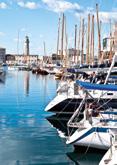 di /by Rino Lombardi
di /by Rino Lombardi
La Bora al mare Bora at sea
La Lanterna
In principio c’era una fiamma su uno scoglio, poi la terra rubò posto al mare. Così nel 1833 venne eretto il bel faro neoclassico disegnato da Matteo Pertsch e rimasto attivo fino al 1969. Vale la pena di girarci attorno, e magari salirci, quando è possibile.
In the beginning was a flame on a cliff, but then the earth forced the sea to retreat. And so it was that in 1833 the beautiful neoclassic lighthouse designed by Matteo Pertsch came to be, and remained operational until 1969. It is worth a closer look – if you are lucky, you may even climb to the top.
Anche lei adora tuffarsi nel golfo di Trieste. Ma d’estate è meno forte che in inverno, diventa borino e rende più sopportabile il caldo in riva al mare. Per prevenire i voli di asciugamani, materassini & co. si suggerisce di usare sassi o altre zavorre creative.
She, too, loves to dive into the Gulf of Trieste. Softened by the summer, she turns from Bora into Borino, a cool breeze and a welcome respite from the unremitting heat of the seaside. Tip: stock up on pebbles, rocks, or any other ballast form, lest a mischievous gust steal your beach towels, mats, and floats.
Faro della Vittoria
Faro della Vittoria Progettato da Arduino Berlam il faro splende anche quando la luce è spenta grazie alla pietra bianchissima di Aurisina e di Orsera che lo riveste. Curiosità: la Vittoria alata in bronzo posta sulla sua cima nasconde uno straordinario meccanismo per resistere alle raffiche di Bora.

Faro della Vittoria, the lighthouse of victory, designed by Arduino Berlam, shines even when the light is off, thanks to the pure white limestone of Aurisina and Orsera covering its walls. Interesting fact: the bronze statue of the Winged Victory at the top of the lighthouse has an internal mechanism that enables it to withstand even the strongest gusts of Bora.
Il mar dello sport Sea of sport
Il golfo di Trieste è uno straordinario campo di gara per gli sport del mare, dalla vela, al canottaggio, dal windsurf, al sup, e, ovviamente, al nuoto e agli sport subacquei. Ma il mare oltre che uno spazio, è anche uno sfondo, splendido, per chi ama fare corse e corsette.
The Gulf of Trieste is an extraordinary marine race track, where athletes compete in every possible discipline of water sports: sailing, kayaking, windsurfing, standup paddleboarding (SUP), and, of course, swimming and underwater diving. Even those who race on dry land, like runners and marathon runners, appreciate the presence of the sea, which provides them with a charming scenery.
20
TOP
–
–
01 04 03 02
–
–
24 IES, TRIESTE LIFESTYLE N°21 — Summer 2023 Città da scoprire
Vista mare Sea view
Ci sono scrittori come Grillparzer o Stifter che qui videro il mare per la prima volta, arrivando da quella che si chiama ancora Strada per Vienna. Ma ci sono tanti luoghi speciali per ammirare il grande blu. Da San Giusto o da via Ciamician? Da Conconello o dalla Napoleonica? Etc, etc. Buona visione!
Writers like Grillparzer and Stifter saw the sea for the first time here in Trieste, approaching the Gulf from Strada per Vienna. But this is not the only place where you can enjoy a view of the sea. Indeed, Triestini are truly spoilt for choice: San Giusto or Via Ciamician? Conoconello or Strada Napoleonica? Take your pick and enjoy the view!
Un bagno vintage A vintage bathing experience

Vicinissimo al Pedocin, l’Ausonia è uno stabilimento balneare dal sapore e dall’architettura anni ‘30. A Trieste, forse più che altrove, andare al mare, o come si dice qui “al bagno”, è entrare in una dimensione senza tempo: siamo nel XXI secolo ma sembra di essere ancora nel XX.
Right next to Pedocin, Ausonia is a bathing establishment, whose taste and design date back to the 1930s. Here in Trieste, perhaps more than anywhere else, going to the seaside, or rather going “to the bath”, as the locals say, means entering a timeless dimension: a 21st-century swim in a 20thcentury atmosphere.
Il mare di Miramare The sea of Miramare
Il 28 maggio 1973 veniva affidata al WWF la prima concessione dello specchio acqueo antistante il Castello per farne un “Parco marino per la conservazione della flora e fauna dell’Alto Adriatico”. È la prima riserva marina nata in Italia e nel 2023 festeggia i suoi 50 anni!

On 28th May 1973 the inshore waters of the Castle were put under the aegis of the WWF, to establish a “Marine reserve to protect flora and fauna of the High Adriatic”. It was Italy’s first marine reserve and this year we celebrate the 50th anniversary of its foundation!
Aquario!
Scrivere Aquario invece di Acquario, altrove sarebbe un errore imperdonabile, ma a Trieste si fa eccezione. L’insegna principale qui è scritta proprio così, bene in grande sulla parte alta della facciata e… senza la C! Perché? Perché ricorda il latino “aquarium”. La curiosità non è mai uno sbaglio!
According to the correct Italian spelling, “Aquario” is missing a “c”. Not in Trieste, though, where the (misspelled) term dominates the top of the façade of the city aquarium. This “poetic licence” is actually a reference to the Latin (and English) spelling of “aquarium”. Mistakes are irrelevant when you learn new things!
Marinaresca
“Una fresca bavisela” (una dolce brezza) è la canzone di mare più amata dai triestini.
“Ma se stanòte… ciàpo una sirena / mi te la vojo domani regalàr”. Il pescatore promette alla sua bella che se navigando di notte dovesse incontrare una sirena, la donerebbe alla propria amata insieme a tutti i pesci del mare.
“
Una fresca bavisela” (Triestine dialect for “a cool breeze”) is Trieste’s most beloved sea roundelay. “Ma se stanòte… ciàpo una sirena / mi te la vojo domani regalàr” (“but if tonight…I catch a mermaid / tomorrow I want to give her to you”). The fisherman promises his beau that, if he caught a mermaid while sailing at night, he would bring her back to give to his beloved as a gift, together with all the fish in the sea.
#piccolimaritascabili
Cercate questo hashtag su Instagram per scoprire la collezione di scatti effettuati dal fotografo Massimo Gardone, accomunati dallo stesso orizzonte, a Barcola, ma con condizioni meteorologiche sempre diverse.
–Look for this hashtag on Instagram (it literally translates as “tiny pocket seas”) to find out about photographer Massimo Gardone’s pictures: every frame shows the same horizon, as it was taken in the same spot in Barcola; what changes is the weather, different in every picture.
–
–
–
–
05 06 07 09
–
08 10
25 IES, TRIESTE LIFESTYLE N°21 — Summer 2023 Discover the city
M. Cettin
Ammiramare Admiring the sea
A Miramare si può immaginare il mare ai tempi di Massimiliano e Carlotta, lo si vede, lo si respira, ma… non ci si può tuffare. All’interno del parco, tra le tante bellezze, c’è un luogo molto instagrammabile che cita il mare con originalità: la fontana delle conchiglie.
The sea view from Miramare is a threshold to the past: one can look out and imagine the sea that Maximilian and Charlotte used to see… breath in its scent, look at its blue, but … no diving allowed. Among the countless amenities of the park, there is a perfect instagrammable place with a creative memento of the sea: the shell fountain.
Porto unico
One Port
Porto Vecchio, Porto Vecio, Porto Vivo. Ci sono tanti modi di chiamare quest’area in trasformazione. Un luogo unico al mondo dove si racconta il rapporto di Trieste con un mare chiamato passato e un altro mare chiamato futuro.
Magazzino 26 & co.
Futura sede del nuovo grande Museo del Mare, propone al momento una sezione dedicata al deposito a vista delle collezioni del Lloyd Triestino ed è imminente l’apertura di un piccolo museo del mare temporaneo dove ritrovare la straordinaria storia marinara di questa città.
Magazzino 26 (lit. warehouse 26), destined to become the seat of the upcoming great museum of the sea, currently hosts a display of the collections belonging to former Lloyd Triestino. Before the official inauguration, a temporary scaled-down version of the sea museum will soon open to the public, thus providing a taste of the extraordinary marine history of this city.
I mari del mondo
The seas of the world
L’odierno Palazzo della Regione in passato fu la sede del Lloyd Triestino e prima ancora dell’Österreichischer Lloyd, la più grande compagnia di navigazione dell’Impero Austro-Ungarico, che attivò rotte regolari con il medio e l’estremo Oriente, già prima dell’apertura del canale di Suez.
Today’s seat of the regional administration Palazzo della Regione used to host the headquarters of former Lloyd Triestino, and, before that, of Österreichischer Lloyd, the largest shipping company of the Austro-Hungarian Empire, running regular services to the Near- and Far East even before the inauguration of the Suez Canal.
Porto Vecchio, Porto Vecio, Porto Vivo: old port, off port, live port. This place is called by many names as it undergoes its transformation. There is no other place like this in the whole world – a place that tells the tale of Trieste and her two seas: one is named Past, the other is named Future.
Mari lontani
Distant seas
Mare a Trieste è anche ricerca. La nave rompighiaccio “Laura Bassi” dell’OGS l’Istituto Nazionale di Oceanografia e di Geofisica Sperimentale porta il nome della “città della scienza” nei mari polari per effettuare importanti ricerche nei luoghi che conservano la memoria climatica del pianeta.


In Trieste the sea is also synonymous with research. The icebreaker “Laura Bassi” of the National Institute of Oceanography and Applied Geophysics – OGS was flagged and registered with the district of Trieste and now carries the name of the “city of science” on her polar missions to contribute to research on the Earth’s climate history.
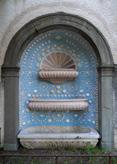
13
–
–
–
11 14 15 12
–
–
F. Parenzan
G. Aiello 26 IES, TRIESTE LIFESTYLE N°21 — Summer 2023 Città da scoprire
P. Carmichael

L’osmiza vista mare
Osmiza with a sea view

Si può gustare il mare di Trieste in riva al mare, in un piatto di pesce del golfo, ma si può assaporare anche semplicemente con gli occhi, dall’alto, godendosi un vassoio di salumi, formaggi e vino del territorio in una delle osmize che si affacciano sul golfo. Lo spettacolo è sempre unico!
The taste of Trieste’s sea is served at your seaside table: either as a local seafood course, or simply as a feast for the eyes, you can admire the sea from above, as you enjoy a plate of cured meats, a cheese platter, and a glass of local wine in one of the numerous osmize overlooking the Gulf. A breath-taking and mouthwatering view!
Porto d’artista Fine art port
Nel 1907 Egon Schiele, a 17 anni si ferma in città per due giorni e realizza “Il porto di Trieste”, olio e matita su cartone, dove lo stile espressionista si nota nelle linee che si riflettono nell’acqua, create usando la matita nella pittura ancora bagnata. L’opera appartiene ora a un collezionista privato, da qualche parte nel mondo…
Quando tramonta il sole
When the sun sets
Trieste è una delle città con la maggiore produzione di foto pro capite all’ora del crepuscolo. Tutto il giorno da queste parti c’è una luce speciale, ma alla sera, prima che il sole s’immerga nel mare, i colori del cielo sono capaci di fare meraviglie!


Trieste is one of the cities with the highest rate of pictures taken per person at sunset. The light is spectacular at every hour of the day, but right before the sun disappears into the sea the colours of the sky are pure magic!
Molo da passeggio
A pier for a stroll
C’è un modo tutto triestino di raggiungere l’orizzonte. Basta camminare lungo il Molo Audace, fino ad arrivare alla Bitta dei Venti. A questo punto si può dare uno sguardo a tutto il golfo e oltre, oppure basta girarsi di 180° e godersi una bella veduta della città, magari alle prime luci della sera. Et voilà!
Triestini have their own, unique way of reaching for the horizon: they take a stroll along Molo Audace, all the way to the Bitta dei Venti, at the very edge of the pier. Here you can embrace the entire Gulf with your gaze, or turn your back to the sea and enjoy a stunning view of the city, preferably at dusk. There you go!
In 1907 a then 17-year-old Egon Schiele spent a couple of days in Trieste, where he painted his “Hafen Von Triest (Harbor Of Trieste)”: in this oil and pencil on cardboard Schiele’s expressionist signature style emerges from the lines reflected on the water surface, which he rendered by using the tip of a pencil on wet oil paint. Today, the painting is hanging somewhere in a private collection…
gulf, many seas
Un golfo, tanti mari One
“I mari di Trieste”. Una bella antologia curata da Federica Manzon che racconta il rapporto speciale degli scrittori triestini con questo “mare diverso da qualsiasi altro, che da subito cambia nome e diventa più familiarmente “bagno”. Testi di Magris, Pahor, Dorfles, Covacich, Roveredo, Spirito, Tolusso, Mezzena Lona, Heinichen (Ed. Bompiani).
“I mari di Trieste” (i.e., the seas of Trieste). A beautiful compendium edited by Federica Manzon that illustrates the bond between Trieste-born writers and this “unique sea, whose friends call it with the more familiar pet name ‘bagno’ (i.e., bath)”. Manzon’s anthology features passages by Magris, Pahor, Dorfles, Covacich, Roveredo, Spirito, Tolusso, Mezzena Lona, and Heinichen.
–
–
–
–
–
16 17 18 19 20 P. De Cassan 28 IES, TRIESTE LIFESTYLE N°21 — Summer 2023 Città da scoprire

Estate, sole, caldo... Come viverli al meglio? Stare all’aperto tutti insieme oppure tenersi i piccoli, grandi piaceri della bella stagione tutti per sé?
Il modo più facile di uscire di casa è vivere al meglio casa propria. Oggidì è sempre più diffusa la ricerca di case con giardini di proporzioni ridotte, oppure di appartamenti con terrazze, per godersi appieno la dimensione en plein air
Una volta soddisfatto questo desiderio, come arredare l’open space più open che c’è?
Questa estensione della casa verso l’esterno merita tutta l’attenzione che abbiamo dedicato all’interno. Una volta l’argomento veniva trattato un po’ sbrigativamente, con l’inserimento di un tavolo, delle poltroncine e magari di un grill. Tutto veniva predisposto creando

una zona pranzo, ma senza le pareti intorno. Il lettino, la brandina, eventualmente l’amaca, erano l’unica soluzione per starsene un po’ in relax. Negli ultimi anni, il settore dell’arredo per esterni è cambiato radicalmente ed è letteralmente esploso con nuove idee, nuove soluzioni, nuove ispirazioni.
E con nuove contaminazioni, in particolare dai Paesi del nord Europa, che ci hanno insegnato come adoperare gli spazi esterni meglio e sempre, 365 giorni su 365 o quasi. Sono nate aziende specializzate che forniscono arredi per esterni seguendo l’evoluzione di un mercato che diventa sempre più sofisticato. È nato perfino un corso della facoltà di architettura legato a questa tematica, si chiama “Design e architettura del paesaggio”.
Così va a finire che oggi negli spazi
INTERNO 8 NOTIZIE
Outdoor news
DALL’ESTERNO
30 IES, TRIESTE LIFESTYLE N°21 — Summer 2023 Contributors
di /by Ottavio Silva
all’aria aperta trovano posto divani, poltrone, tavolini, tappeti, lampade e tanti altri complementi. Tutti rigorosamente “da esterni”.
Ovviamente non ci s’inventa produttori e arredatori da un giorno all’altro, perché tutti i materiali che compongono i mobili subiscono un forte stress se messi all’esterno. Ci vogliono solide certezze.
I tempi cambiano e deve cambiare anche il modo di affrontare il tempo da parte delle cose! A tal fine è stato intrapreso un grande lavoro di ricerca da parte delle aziende, sia quelle “storiche” sia quelle più “giovani”, per creare materiali capaci di resistere alle intemperie, ma non solo. È fondamentale anche essere capaci di offrire quella piacevole sensazione di benessere e di comodità che tutti cerchiamo per vivere al meglio casa nostra, sia che si tratti di materiali naturali che di quelli prodotti dall’uomo. Così sono stati creati tessuti speciali, materiali innovativi per le imbottiture, insieme a tante altre novità che riescono ad accogliere le (sacrosante) esigenze di resistenza e di comodità di chi vuole vivere fuori-casa-restando-dentro-casa.
Le aziende del settore vivono un’autentica primavera, esibendo collezioni sempre più belle e confortevoli. Un esempio per tutti: il tappeto. Negli anni sono stati sviluppati materiali sintetici che consentono di realizzare manufatti molto belli e con ottime prestazioni in fatto di resistenza.
Da quello che una volta era chiamato “arredo per esterni”, siamo arrivati così al “salotto per esterni”. Davanti al mare, in campagna, in città, ovunque, il desiderio è uno e trino: essere circondati dalla bellezza, essere rassicurati dalla robustezza, essere coccolati dal confort. Da Zinelli & Perizzi c’è una mentalità bella aperta in questo senso.
Summer, sun, heat... How best to experience them? Get outdoors all together or keep the small, big pleasures of the warm season all to yourself? The easiest way to get out of the house is to live your home to the fullest. Nowadays, it is becoming more and more common to find houses with smaller sized gardens, or apartments with terraces, in order to fully enjoy the en plein air dimension. Once this desire is satisfied, then how can we furnish the most open space there is? This extension of the house to the outside deserves all the attention we have given to the inside. This topic used to be treated somewhat hastily, with the inclusion of a table, armchairs, and perhaps a grill. Everything was set up creating a dining area, but without the walls around it. The lounger, the cot, possibly the hammock, were the only way to sit back and relax. In recent years, the outdoor furniture industry has changed dramatically and has literally exploded with new ideas, new solutions, new inspirations. And with new contaminations, especially from northern European countries, which have taught us how to use outdoor spaces better and almost all year round. Specialized companies now provide outdoor furniture, following the evolution of a market that is becoming more and more sophisticated. There is even a course in the faculty of architecture related to this issue, it is called “Landscape Design and Architecture.”
So it turns out that nowadays sofas, armchairs, coffee tables, rugs, lamps and many other accessories find their place in outdoor spaces. All of them strictly “outdoor”. Of course, we do not invent manufacturers and interior designers overnight, because all the materials that make up furniture undergo great stress when put outside. It takes solid certainties. Times change, and the way things face the weather must also change!
To this end, a great deal of research work has been undertaken by companies, both “historic” and “younger” ones, to create materials that can withstand the weather, but not only that. It is
also essential to be able to provide that pleasant feeling of well-being and comfort that we all seek in order to experience our homes to the fullest, whether natural or man-made materials. Thus, special fabrics, innovative upholstery materials, along with many other innovations have been created that are able to accommodate our right needs for durability and comfort for those who want to live outside-home-resting-insidehome. Companies in the industry are experiencing a true springtime, displaying more and more beautiful and comfortable collections. One example for all: the carpet. Over the years, synthetic materials have been developed that make it possible to produce very beautiful artifacts with excellent durability.
From what was once called “outdoor furniture,” we have thus arrived at the “outdoor living room.” In front of the sea, in the country, in the city, anywhere, the desire is one and three: to be surrounded by beauty, to be reassured by sturdiness, to be pampered by comfort. At Zinelli & Perizzi we are quite open-minded in this regard.

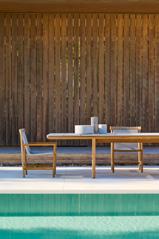
ENGLISH TEXT
31 IES, TRIESTE LIFESTYLE N°21 — Summer 2023 Contributors
UN TUFFO CON FIDO
A dive with Rover
Molte città, Trieste in particolare, sono sempre più pet friendly: quasi tutti gli esercizi pubblici accolgono con piacere gli amici a quattro zampe. Nelle giornate più calde bar, ma anche negozi o locali posizionano all’esterno delle ciotole con acqua fresca per aiutare i nostri pelosetti a difendersi dalla canicola estiva. Ma al mare, possiamo portarli? Certo che si! Fido & C. possono, purché tenuti al guinzaglio, sguazzare e farci compagnia, in numerosi tratti di spiaggia libera.
Primo tra tutti il lungomare di Trieste che si dipana dal bivio del Castello di Miramare fino alla pineta di Barcola. È un luogo particolare, amatissimo dai triestini, che suscita lo stupore dei visitatori: si tratta di una zona costiera, attrezzata per la discesa al mare, che termina una vasta pineta, organizzata con chioschi, fontanelle e giochi per bambini. Attenzione nell’area denominata ex Cedas gli animali possono accedere solo dalle 20:30 a mezzanotte.
Chi non ama la costa alta può scegliere di andare ai “Filtri”- come dicono i triestini. Una spiaggia di sassolini, di dimensioni contenute, dove le risorgive del fiume Timavo rendono lo specchio di mare fresco e cristallino. Un ottimo refrigerio nelle giornate torride, ma senza servizi.
Tra gli stabilimenti dedicati ai cani troviamo “Fido Lido” a Muggia, a ingresso libero, e “Bau Beach” a Sistiana.
“Fido Lido” è un parco, con accesso gratuito, dedicato interamente agli amici a 4 zampe e ai loro padroni. Una vasta area ombreggiata con tavoli da picnic, box cani a noleggio e due spazi
per sgambatura. La spiaggia è dotata di chiosco bar, fontanella attrezzata anche per fare la doccia ai cani, noleggio sdraio, campo beach volley e giochi per bambini.
“Bau Beach” è invece una spiaggia dotata di lettini e ombrelloni distanziati, offre anche la possibilità di noleggio della brandina per il cane o di uno spazio dedicato all’interno di box recintati con lettini ombrellone e brandina. L’area è fornita di docce, e doccino per il cane. (www.baiadisistiana.com).

E allora… buon mare a tutti!
ENGLISH TEXT
Agrowing number of cities is adapting to this trend, by becoming increasingly pet friendly – and Trieste is no exception: almost every public establishment here welcomes four-legged guests. When the searing heat of summer days hits its peak, most cafés, but also shops and businesses, place bowls of fresh water at their entrance to help fluffy patrons quench their thirst. And what about the seaside? Rover & co. are welcome there as well, provided they are on a leash: they can swim and rest ashore on the numerous stretches of free-access coast.
Take Trieste’s seafront, for instance: this long seaside promenade stretches from the fork dividing the main road
from the access road to Castello di Miramare, all the way to Barcola pine grove. A locals’ favourite spot, and a delightful surprise for visitors: this paved stretch of coast is equipped with safe access points to the sea, kiosks, water fountains, and children’s play areas, all the way to the shade of the pine grove. Note: animals are allowed to access the area known as “ex Cedas” only between 8:30 p.m. and 12:00 p.m.
Those who prefer the shore to be at sea level may head to the “Filtri” (i.e. filters), as the locals call it: a cosy pebbled strand caressed by crystal-clear water, made pleasantly cooler by the springs of the Timav river. A perfect cooling spot. No services.
Pet-friendly bathing establishments include Muggia’s “Fido Lido” (free entry) and Sistiana’s “Bau Beach”.
“Fido Lido” is a public park fully equipped for dogs and dog lovers. There is a vast shady area with picnic tables, rental dog beds, and two grooming setups; and a serviced beach, with a food kiosk, a fountain for drink water and dog wash, rental sunbeds, a beach volley field, and children’s playgrounds.
“Bau Beach” is a bathing establishment with spaced-out sunbeds and shades, which offers rental dog beds. There is also a separate area with fenced-in dedicated sun- and dog beds with beach umbrellas. Bau Beach is equipped with showers and dog wash. (www.baiadisistiana.com).
Everyone, enjoy!
INFO fidomicio.comune.trieste.it
di /by Ilaria Romanzin
32 IES, TRIESTE LIFESTYLE N°21 — Summer 2023 Città da scoprire

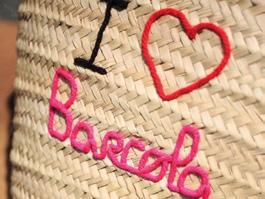

N°21 — Summer 2023 34 IES, TRIESTE LIFESTYLE Portfolio
Sono gli occhi di Massimiliano e Carlotta. È questa l’idea che mi ha guidato nella realizzazione di questi scatti fotografici: immedesimarmi nello sguardo dei due coniugi mentre passeggiano silenziosi negli spazi del castello e del parco, rappresentati dunque non come luoghi da visitare ma piuttosto come spazi di vita quotidiana, per quanto straordinari. Un salto nel passato dove svaniscono le moltitudini di turisti e rimane Massimiliano il quale, alzatosi presto in un tiepido mattino di primavera, passeggia nel suo parco traguardando il castello illuminato dalle prime luci dell’alba; oppure Carlotta, assorta a fissare le geometrie della fontana mentre è seduta a leggere un libro, avvolta dalla calda luce del sole al tramonto. Ho ricercato una fotografia lineare e senza forzature dettate dalla tecnica perché la fotografia è prima di tutto questione di luce… e sensibilità.
–They are the eyes of Maximilian and Carlotta. This is the idea that guided me in the creation of these photo shots: empathizing with the gaze of the couple as they stroll silently through the castle and the park, represented therefore not as places to visit but rather as spaces of everyday life, although extraordinary. A leap into the past where the multitudes of tourists fade away and Maximilian is the only one left: he gets up early on a warm spring morning and strolls through his park, gazing at the castle illuminated by the first light of dawn; or Carlotta, absorbed in staring at the geometries of the fountain while reading a book, enveloped in the warm light of the setting sun. I sought a linear photograph without technical constraints because photography is first and foremost a matter of light... and sensitivity.
 Foto e testo di/Photo and text by Fabio Parenzan
Foto e testo di/Photo and text by Fabio Parenzan
N°21 — Summer 2023 35 IES, TRIESTE LIFESTYLE Portfolio

 A sinistra /Left Andreina Contessa, direttrice del Museo storico e il Parco del Castello di Miramare. Andreina Contessa, director of the Miramare Castle.
A sinistra /Left Andreina Contessa, direttrice del Museo storico e il Parco del Castello di Miramare. Andreina Contessa, director of the Miramare Castle.
N°21 — Summer 2023 36 IES, TRIESTE LIFESTYLE Portfolio
A sinistra /Left Affacciato sul verde e sul blu, uno dei romantici balconi del Castello. Overlooking the green and the blue, one of the romantic balconies of the Castle.




N°21 — Summer 2023 37 IES, TRIESTE LIFESTYLE Portfolio




N°21 — Summer 2023 38 IES, TRIESTE LIFESTYLE Portfolio
A destra /Right
Il Bagno Ducale, la cabina balneare del duca Amadeo d’Aosta, gode di un affaccio sul mare e di una vista panoramica sul castello da togliere il fiato.

The Duke’s Bath, the changing booth of Duke Amedeo of Aosta, affords a view of the sea and a breath-taking panoramic sight of the Castle.
A destra /Right
Mitja Gialuz, presidente della Società Velica Barcola
Grignano –il circolo che organizza la Barcolana, la regata più grande del mondo
(Barcolana 55: 8 Ottobre 2023)– con alle spalle il Castelletto di Miramare.
Mitja Gialuz, president of the Società Velica Barcola
Grignano –the yacht club that organizes the Barcolana, the largest regatta in the world
(Barcolana 55: 8 October 2023)– with the “Castelletto” behind him.

–
–
N°21 — Summer 2023 39 IES, TRIESTE LIFESTYLE Portfolio
L’antica stazione ferroviaria, un altro gioiello architettonico
The old Miramare railway station, another architectural jewel

Fabio Parenzan
Fabio Parenzan classe 1960, Maestro artigiano fotografo dal 2018, allievo del maestro Ugo Borsatti. Dopo l’esperienza a Milano come fotoreporter dell’agenzia Omega Fotocronache, apre a Trieste lo studio fotografico Visual Art. Nel 1992 vince il concorso nazionale Kodak per il ritratto classico e collabora con la direzione del settore professionale Kodak di Rochester U.S.A.
Giornalista dal 1983, ha immortalato la visita del Principe Carlo al Collegio del Mondo Unito di Duino, la visita a Trieste di papa Giovanni Paolo II, i Mondiali di calcio Italia 90, l’entrata della Slovenia in UE, le visite dei presidenti della repubblica italiana. Fotografo della Fondazione Teatro Lirico G. Verdi dal 1990; nel 1993 allestisce la sua prima mostra dedicata a chi opera dietro le quinte.
Fabio Parenzan, born in 1960, Master Craftsman Photographer since 2018, at a very young age learnt to love and appreciate reportage photography from the wellknown Trieste master Ugo Borsatti. He then worked in Milan as a photoreporter in the Omega Fotocronache. In 1992 he won the Kodak national competition for classic portraits and collaborated directly with the management of the Kodak professional sector in Rochester U.S.A. A journalist since 1983, he has covered the visit of Prince Charles to the United World College of the Adriatic, the visit of Pope John Paul II to Trieste, the Italia 90 World Cup, the entry of Slovenia into the European Union, the visits of the Presidents of the Italian Republic Scalfaro, Ciampi, Napolitano. He has been the official photographer of the G. Verdi Opera Theatre Foundation since 1990.

Ascolta il podcast di Boramata dedicato a Miramare
Inquadra il QRcode e ascolta su Spotify i podcast della serie “La Bora si sente”, il vento che racconta Trieste –
Scan the QRcode and listen to the Spotify podcast “La Bora si sente” the wind that tells the story of Trieste.
–
N°21 — Summer 2023 40 IES, TRIESTE LIFESTYLE Città da gustare
la cultura,
Leggere un libro. Visitare una mostra. Ascoltare un concerto. Raramente si pensa che si tratta di autentici “privilegi”: oggi condivisi da molti, ma ancora (anche se può apparire strano) preclusi ai più.
La cultura, per progredire, richiede continue “chiavi di accesso”. Dalle più elementari (come il saper leggere) ad altre più sofisticate, che la cultura stessa, quasi per “geminazione”, crea di continuo.
Chiavi che ci consentono di scrutare orizzonti sempre più affascinanti e impegnativi (percepire l’enigma di una statua greca, di un quadro astratto o di un brano musicale, al di là della mera contemplazione).

Chiavi che durano per sempre. Che affinano gusto e capacità di giudizio. Che non possiamo smarrire e che nessuno ci potrà mai rubare. Che potremo condividere e scambiare con altri.
La cultura, innegabile segno di benessere sociale. Ma anche matrice di autentica felicità individuale.
sono infiniti buoni motivi per incoraggiare e sostenere la cultura in tutte le sue migliori espressioni. La Fondazione lo crede da sempre.
il colore del benessere sociale
quasi un processo di “geminazione”
Ci
Tra le stanze del Castelletto
Inside the rooms of the Castelletto
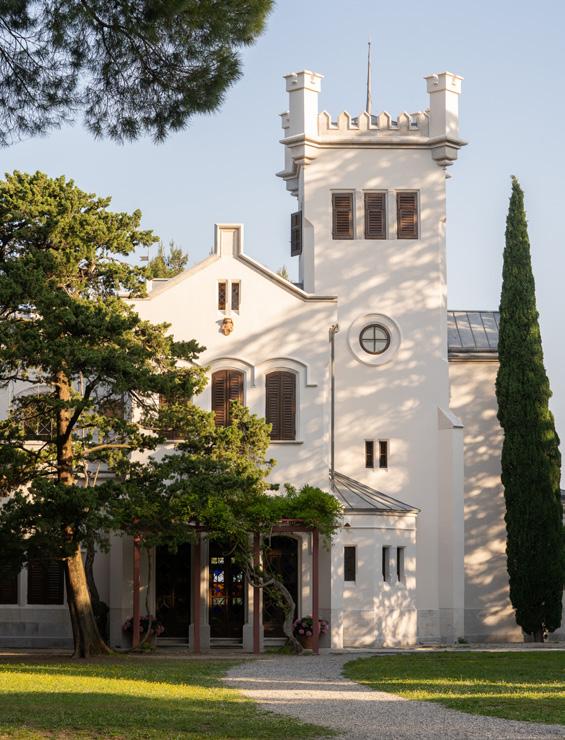
F. Parenzan 42 IES, TRIESTE LIFESTYLE N°21 — Summer 2023 Città da vivere
Isabella Franco
La prima dimora di Massimiliano e Carlotta —
Maximilian and Charlotte’s first home
Come una storia d’amore, timida, appena vissuta, l’ultima sorpresa svelata del Parco di Miramare è il Castelletto. Una piccola casa, se paragonata al suo fratello maggiore che si erge altero ed elegante a picco sul Golfo di Trieste. Dalla sua romantica terrazza, ingraziosita da un maestoso glicine, l’arciduca Massimiliano d’Asburgo controllava che i lavori della dimora padronale procedessero secondo i suoi rigorosi dettami. Nelle sue stanze ombrose, ognuna con un nome e una precisa destinazione, la bellissima Carlotta del Belgio, confidava alla dama di compagnia reconditi segreti e timide speranze, quasi sempre legate al suo sposo. La storia d’amore di Massimiliano e Carlotta pervade tutto il complesso di Miramare e, di sicuro, è uno degli elementi che rendono così attraente e affascinante questo luogo unico. Unico perché non c’è un altro castello bianco e così distinto che si erge a picco su un mare blu, contornato da un parco storico ricco di specie botaniche rare e alberi monumentali. Ma sono la caparbia volontà, il curioso e affannoso desiderio di sapere dell’arciduca Massimiliano uniti alla personalità di Carlotta, che hanno dato il vero carattere distintivo a Miramare. Si racconta che lei avesse ricevuto un’educazione molto austera, un rigido senso del dovere che le era stato imposto dall’appartenere a una delle dinastie più importanti d’Europa, al contrario della cognata Elisabetta d’Austria Sissi, che qui a Miramare certo si sentiva meno vincolata ai doveri di corte, fra i
sentieri fioriti e alla vista del mare da cui era sempre pronta a salpare. Verosimilmente, furono quelli vissuti al Castelletto gli anni più felici per Massimiliano e Carlotta. Il recente restauro, lungo e accurato, ha restituito a questo edificio che si staglia sulla baia di Grignano e si intravede percorrendo la strada Costiera arrivando a Trieste, il tono sobrio dello spirito al quale era stato improntato. A cominciare dalla cromia esterna, prima un giallo ocra frutto di una tinteggiatura in epoca moderna, ora il bianco candido che aveva in origine. Anche gli interni sono stati restaurati secondo i più rispettosi canoni di conservazione. Al primo piano le sale si disvelano ciascuna nei diversi stili come uno scrigno nello stile tipico della metà dell’Ottocento specchio del gusto eclettico del committente. Al piano terreno sono state riportate alla luce le decorazioni pittoriche ottocentesche completamente cancellate agli inizi del Novecento e di cui si era perduta memoria. Tutti gli ultimi interventi a Miramare, sia nel Parco sia nel Museo, sono improntati ai dettami della conservazione e del restauro filologico, della tutela, della sostenibilità e della pubblica fruizione.

Così è anche per l’ultima delle grandi aperture, le Antiche Cucine del Castello che, per la prima volta, consentiranno ai visitatori di sbirciare anche dietro lo sfarzo delle sale dove si svolgeva la vita di corte, capire come si allestivano le tavole e cosa offrivano gli arciduchi ai loro ospiti, riscoprendo anche la dimensione più privata del castello più romantico d’Europa.
Guided tours
A) Cucine storiche
+ Bagno ducale
B) Castelletto
+ Terrazza dei cannoni + Serre Nuove/Orangerie
Servizio su prenotazione per gruppi di minimo 10 persone. Visite a cadenza fissa settimanale il giovedì, tra giugno e settembre 2023 durata circa 1 ora e 30 cad.
A) Ancient kitchens + Duke’s Bath
B) Castelletto + Cannon terrace + New greenhouses/ Orangerie
Upon reservation, min. 10 people. Weekly visits on Thursday from June to September 2023
Duration: 1 hour and 30 minutes per tour.
Tariffe /Entrance fees
Intero /Full price: € 20 (accesso € 10, guida € 10) /(access € 10, service € 10)
Gratuito: per bambini
accompagnati fino a 6 anni /Free entrance: accompanied minors up to 6 years of age
Per agevolazioni, gratuità e informazioni dettagliate /Find out more about discounts, free tickets, and further details
di /by
Visite guidate
www.miramare.cultura.gov.it
43 IES, TRIESTE LIFESTYLE N°21 — Summer 2023 Live the city
M. Weber
From the Castelletto romantic terrace the strict and fastidious eyes of Archduke Maximilian of Hapsburg supervised the construction of his castle.
The bashful looks exchanged at the beginning of a love story: such is the atmosphere of the Castelletto, the latest treasure unveiled in the Park of Miramare. Almost a cottage when compared to its older brother, standing so high and proud, perched over the Gulf of Trieste. From its romantic terrace, under the shade of a majestic wisteria, the strict and fastidious eyes of Archduke Maximilian of Hapsburg supervised the construction of his castle. In her shaded rooms, each with a name and a purpose, beautiful Charlotte of Belgium, known by her Spanish name, Carlota, whispered to the ear of her lady-in-waiting, disclosing her innermost thoughts and timid hopes, almost always revolving around her spouse.
The love story of Maximilian and Carlota reverberates in every corner of Miramare and is without a doubt one of the reasons why this unique place is so fascinating and intriguing. Unique, because no other castle in the world stands so white and elegant over the blue sea, surrounded by a historic park, full of exotic plants and monumental trees. And even more so, thanks to Archduke Maximilian’s inquisitive and stubborn mind, determined to pursue every facet of knowledge; as well as Carlota’s distinctive character. She was said to have received a very rigorous education, instilled with the inflexible sense of duty dictated by her lineage, one of the oldest dynasties of Europe – unlike her cousin Elisabeth “Sissi” of Austria, who must have walked these floors enjoying a feeling of temporary freedom, finally away from court protocols and duties, surrounded by blooming gardens and the view of the sea, always ready to trace the course of her next journey.
The years they spent living in the Castelletto are quite likely the happiest time in Maximilian and Carlota’s married life. After the latest, long, and thorough restoration process, the Castelletto is once again the jewel that used to shine over the bay of Grignano, elegant yet sober as it was originally intended, and is now visible from Strada Costiera in direction Trieste. The outer walls, covered in a yellow-ochre coat applied in modern times, are now back to their original pure white. The same conservative approach was applied to the interior. The first-floor rooms line up like treasures in a jewellery box, each with its own distinctive style, as was the custom in the mid-19th century, and in line with eclectic taste of the client. The ground floor now displays the original 19th-century wall-painting decorations that were completely cancelled in the early 1900s and had passed – albeit briefly − into oblivion. The entire restoration effort involving both the Park and the Museum of Miramare was carried out in line with the principles of conservation, philological restoration, preservation, sustainability, and public access.
The latest space open to the public, le Antiche Cucine del Castello [i.e., the Castle’s ancient kitchens], provides visitors with the unprecedented opportunity of taking a peek beyond the splendour of court life, at the way banquets were prepared and food was chosen for the archdukes and their guests – a glimpse into the most private aspects of the most romantic castle in Europe.
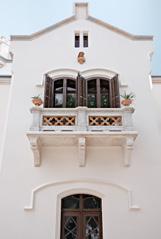
ENGLISH TEXT
Dalla romantica terrazza del Castelletto l’arciduca Massimiliano d’Asburgo controllava che i lavori della dimora padronale procedessero secondo i suoi rigorosi dettami.
M. Weber 44 IES, TRIESTE LIFESTYLE N°21 — Summer 2023 Città da vivere


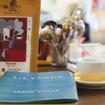


Old Port, Live Port

INFO www.discover-trieste.it www.triestecultura.it
CULTURA PORTO VECCHIO, PORTO VIVO
46 IES, TRIESTE LIFESTYLE N°21 — Summer 2023 Contributors
Tra i magazzini del vecchio porto di Trieste, alle porte di una città in fermento, continuano i lavori di ristrutturazione di un’area da troppi anni in disuso e che sta pian piano ritornando in possesso di cittadini e turisti.
A fianco del viale monumentale, progetto da 19 milioni di euro che collegherà il centro storico al terrapieno di Barcola, prenderà vita il nuovo Museo del Mare progettato dall’architetto Guillermo Vazquez Consuegra; sarà il cuore pulsante del polo museale già in essere all’interno del ristrutturato Magazzino 26. Qui, infatti, trova spazio la mostra permanente “Lloyd. Deposito a vista” realizzata dal Museo del Mare e che racconta la storia della celebre compagnia di navigazione. Visitabile gratuitamente da giovedì a domenica, dalle 10 alle 19, le sezioni della mostra percorrono le tante vicende del Lloyd austriaco e triestino che si intersecano con il più ampio quadro della marineria. Sempre al piano terra si possono ammirare i diorami e i modelli di imbarcazioni provenienti dal vecchio museo del mare sito, un tempo, in Campo Marzio, in quello che era il Lazzaretto.
Ma il mare è anche scienza e in questo edificio si trova la sede dell’Immaginario Scientifico, un museo, frutto delle collaborazioni delle tante organizzazioni scientifiche che operano a Trieste, dove tutto è in continuo movimento e dove si può imparare la scienza giocando (www. immaginarioscientifico.it).

Fino al 30 luglio nella Sala Carlo
Sbisà, una delle tre sale espositive del Magazzino 26, “Il Mito dell’arte africana nel ’900” esplora gli artisti del Novecento del calibro di Picasso, Man Ray, Calder, Basquiat e Matisse che sono stati influenzati dall’arte africana, attraverso un percorso fatto di confronti e riscontri dove il visitatore si trova inizialmente immerso nelle opere dell’arte africana per poi coglierne l’essenza nelle opere create dagli artisti del Novecento. (www.navigaresrl.com/mostra/ il-mito-dellarte-africana-del-900)

Nella Sala Leonor Fini durante l’estate si susseguiranno due esposizioni: la prima, “Espressioni a confronto”, in coorganizzazione con il Gruppo artisti triestini Rivel’Art, giunta alla seconda edizione, ospita dal 9 luglio al 20 agosto i lavori di artisti non professionisti, ciascuno in mostra con alcune opere scelte a rappresentare suoi pensieri ed emozioni. Dal 24 agosto al 24 settembre spazio a “Natura biorobotica”, un’esposizione a cura di Gruppo 78 International Contemporary Art che rientra nel programma di Robotics, Festival di Arte e Robotica e altre tecnologie, giunto alla IV edizione.
Fiore all’occhiello del Magazzino 26 è la Sala Luttazzi, intitolata al Maestro Lelio –cui ricorrono quest’anno i 100 anni dalla nascita– che vuole essere sempre più un luogo centrale per l’offerta teatrale, musicale e culturale della città. In questo periodo è prevista una pausa estiva che permetterà di eseguire lavori necessari prima dell’inizio della nuova stagione della rassegna “Una Luce sempre accesa” in avvio in autunno.
La mostra “Il Mito dell’arte africana nel ’900” F. Ruzzier 47 IES, TRIESTE LIFESTYLE N°21 — Summer 2023 Contributors
L’Immaginario Scientifico al Magazzino 26
Among the warehouses of the Old Port of Trieste, at the gates of a city in turmoil, renovation work continues on an area that has been disused for too many years and is slowly coming back into the hands of citizens and tourists alike.
Next to the monumental avenue, a 19 million euro project that will connect the old city centre to the Barcola embankment, the new museum of the sea designed by architect Guillermo Vazquez Consuegra will come to life; it will be the beating heart of the museum centre that is already inside the renovated Warehouse 26. Here, in fact, the permanent exhibition ‘Lloyd. Depot on view’ set up by the Maritime Museum to tell the story of the famous shipping company. The exhibition, which can be visited free of charge from Thursday to Sunday, from 10 a.m. to 7 p.m., traces the many happenings of the Austrian and Trieste Lloyd that intersect with the broader picture of seafaring. On the ground floor you can also admire dioramas and models of boats from the old sea museum located in Campo Marzio, in what used to be the Lazzaretto.

But the sea is also science so this building is home to the Scientific Imaginary, a museum, the result of the collaborations of the many scientific organisations operating in Trieste, where everything is in constant motion and where you can learn science by playing (www.immaginarioscientifico.it).
Until 30 July in the Carlo Sbisà Room, one of the three exhibition halls of Magazzino 26, “The Myth of African Art in the 20th Century” explores 20th century artists of the calibre of Picasso, Man Ray, Calder, Basquiat and Matisse who were influenced by African art, through a path made up of comparisons and feedbacks where the visitor is initially immersed in the works of African art and then grasps its essence in the works created by 20th century artists. www.navigaresrl.com/mostra/ il-mito-dellarte-africana-del-900
Two exhibitions will take place in the Leonor Fini Hall during the summer:

the first, ‘Espressioni a confronto’, in co-organisation with the Trieste artists group Rivel’Art, now in its second edition, hosts from 9 July to 20 August the works of non-professional artists, each exhibiting a few works chosen to represent their thoughts and emotions. From 24 August to 24 September space will be given to ‘Natura biorobotica’, an exhibition curated by Gruppo 78 International Contemporary Art that is part of the Robotics programme, the Festival of Art and Robotics and other technologies, now in its fourth edition.
The jewel in the crown of Magazzino 26 is the Sala Luttazzi, named after Maestro Lelio – whose 100th birthday falls this year – which aims to be an increasingly central place for the theatre, music and cultural events in the city. A summer break is planned for this period, which will allow necessary work to be carried out before the start of the new season of the ‘Una luce sempre accesa’ festival in the autumn.
ENGLISH TEXT
L’esposizione permanente “Lloyd. Deposito a vista”
I. Romanzin
48 IES, TRIESTE LIFESTYLE N°21 — Summer 2023 Contributors
I. Romanzin


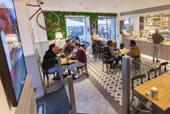
 Lorenzo Michelli
Lorenzo Michelli
Grandi formati, moltitudine di oggetti, di figure, rappresentazioni di scene legate alla vita quotidiana di una società globalizzata, iper colorata, energetica e di grande impatto visivo: David LaChapelle è figlio della pop art. Non a caso fu proprio Andy Warhol uno dei suoi primi sostenitori e datori di lavoro: del giovane artista vennero infatti pubblicate fotografie per la celebre Interview, la rivista che si occupava di celebrità e di scelte d’avanguardia. David LaChapelle è legato a quella arte che nel glamour e nel divismo trova la sua quintessenza. Decine i musicisti e gli attori da lui ritratti. Dalla sua Marilyn debitrice di quella del maestro, a Pamela Anderson, Madonna e Lady Gaga, Bowie e Marilyn Manson. Ma la sua reinterpretazione va a ripescare Michelangelo, i manieristi e Caravaggio piuttosto che la tradizione romantica di un Géricault con l’eccezionale Zattera della Medusa di cui il suo Deluge riprende pathos e posture mantenendo un aggancio continuo con un coloratissimo quotidiano. Il suo lavoro nel tempo è passato dalla commissione all’arte, dalla produzione pubblicitaria alla ricerca personale. La rappresentazione continua ad indugiare su complessi meccanismi visivi ma il sapore che se ne ricava appare più legato alla critica del contemporaneo, sempre condotta con eccezionale vigore visivo; da qui l’idea che l’artista operi per svelare i segni di una decadenza che va abbandonata a favore della sostenibilità, fatta di tempi e spazi migliori. Sarà forse anche per questi motivi che ha deciso di vivere alle Hawaii, in un rapporto stretto con la natura lontano dalla sofisticazione? Certo è che la selezione proposta a Trieste è potente, impattante, ironica, certamente dissacratoria: procura reazioni e sollecitazioni estetiche estese. Riconosciamo l’attualità e la storia dell’arte attraverso un’amplificazione del visivo che ti precipita addosso.
DAVID LACHAPELLE FULMINI
Large formats, a multitude of objects, figures, representations of scenes linked to the everyday life of a globalised society, hyper-coloured, energetic and of great visual impact: David LaChapelle is the son of pop art. It is no coincidence that Andy Warhol was one of his first supporters and employers: photographs of the young artist were in fact published for the famous Interview, the magazine that dealt with celebrities and avant-garde choices. David LaChapelle is linked to that art that finds its quintessence in glamour and stardom. Dozens of musicians and actors have been portrayed by him. From his Marilyn, to Pamela Anderson, Madonna and Lady Gaga, Bowie and Marilyn Manson. But his reinterpretation goes back to Michelangelo, the Mannerists and Caravaggio as well as to the romantic tradition of a Géricault with the exceptional Raft of the Medusa, whose pathos and postures his Deluge takes up, maintaining a continuous link with a colourful everyday life. His work over time has moved from commission to art, from advertising production to personal research. The representation continues to linger on complex visual mechanisms, but the flavour that emerges seems more linked to the critique of the contemporary, always conducted with exceptional visual vigour; hence the idea that the artist works to unveil the signs of a decadence that must be abandoned in favour of sustainability, made of better times and spaces. Perhaps it is also for these reasons that he decided to live in Hawaii, in a close relationship with nature far from sophistication? What is certain is that the selection proposed in Trieste is powerful, impactful, ironic, certainly desecrating: it provokes extensive reactions and aesthetic stimuli. We recognise current events and art history through an amplification of the visual that rushes at you.
ENGLISH TEXT
di /by
A Trieste fino al 15 agosto la spettacolare mostra del fotografo americano
50 IES, TRIESTE LIFESTYLE N°21 — Summer 2023 Città da vivere
In Trieste until 15 August, the American photographer’s spectacular exhibition

INFO www.davidlachapelle-fulmini.it Salone degli Incanti Riva Nazario Sauro, 1 fino al 15 agosto 2023
51 IES, TRIESTE LIFESTYLE N°21 — Summer 2023 Live the city
G. Aiello
L’estate è la stagione musicale per eccellenza: si pensi allo sciabordio delle onde che ti culla nelle serate fresche sul lungomare o al fragore delle mareggiate che si infrangono con forza sugli scogli. A volte, sembra proprio che il mare stia suonando una sinfonia: ci sono le voci fuori campo dei gabbiani, degli schiamazzi dei bambini che giocano, dei baci degli amori estivi e della musica stessa proveniente da una finestra aperta di una casa o da un concerto live di qualche band che anima le serate estive.
A Trieste, grazie alla presenza di molte scuole di musica sul territorio e alle tante tradizioni derivanti dalla musica swing, blues e soul del periodo angloamericano, dello spirito di grandi personaggi importanti del passato, da Lelio Luttazzi a Sergio Endrigo, ai concerti di anima austro ungarica, la voglia di musica si respira in ogni luogo.
Ne è un esempio il cartellone di Triestestate (www.triestestate.it) dove, oltre a rassegne teatrali e cinematografiche, la musica è un elemento portante. Non importa il genere: si spazia dai Carmina Burana rappresentati dall’Orchestra e coro della Fondazione Teatro Lirico Giuseppe Verdi di Trieste (27 luglio, Castello di San Giusto) a Dj Ralf che il 14 luglio nella medesima location presenterà l’originale e innovativo progetto che ha l’ambizione di fondere classica e musica house. Nella città dei teatri il Castello punta a diventare il teatro estivo: sul palcoscenico a San Giusto ci sarà Alice in un omaggio a Battiato (9 luglio), Arturo Sandoval, il più grande trombettista al mondo nonché eccezionale pianista e compositore jazz (12 luglio), Stefano Massimi e Luca Barbarossa (28 luglio), il Padrino dello Swing, Ray Gelato (30/07) e i 40 Fingers, un quartetto di chitarre acustiche composto dai triestini Matteo Brenci, Emanuele Grafitti, Andrea Vittori e Marco Steffè che grazie alla particolare esecuzione di una versione di Bohemian Rhapsody hanno ricevuto i complimenti dei Queen.

La musica dell’estate
The music of summer
di /by
Paola De Cassan
N°21 — Summer 2023 52
LIFESTYLE Città da vivere
IES, TRIESTE
Immancabili le proposte di TriesteLovesJazz e l’omaggio al Maestro Lelio Luttazzi il 17 luglio in piazza Verdi: una serata dedicata ai 100 anni del “giovanotto matto” dove si esibiranno Freddy Colt and His Swing Kids. Gli altri concerti della rassegna si svolgeranno nel giardino del museo Sartorio, da poco rinnovato, e il tradizionale suggestivo concerto all’alba sul molo Audace si terrà domenica 13 agosto.
Ritorna il Festival dell’Operetta che, oltre ai tradizionali appuntamenti, propone pure due serate speciali: “Evviva l’operetta” l’11 agosto in piazza Verdi e uno spettacolo dedicato ai successi della Disney nell’anno del centenario (Castello di San Giusto, 26 luglio).
Ci saranno anche le serate revival anni ‘60-’70 (Ruggente Nostalgia, 12/08), i concerti tributo a De Andrè (16/07, Villa Engelmann), un omaggio a Sergio Endrigo in occasione del 90° anno della sua nascita (12 agosto, giardino del museo Sartorio), la serata Stardust - Tributo a David Bowie a San Giusto il 19 luglio nonché una curiosa serata “Milano-Trieste (andata e ritorno) - 4 agosto, piazza Verdi - dove in un surreale susseguirsi di musica, dialoghi teatrali e sketch le anime vagabonde di Gaber e Jannacci incontreranno i triestini Luttazzi, Strehler, Nereo Rocco e altri ancora.
E nei locali? Noi vi consigliamo di seguire gli eventi organizzati da Creativa che nel dehors di Eataly, oltre a organizzare serate dj, proporrà serate con interessanti gruppi locali; e ancora Mast in via San Nicolò o la Stagione Rogers Outdoor sulle rive di Trieste, Hotello rooftop in via Valdirivo e Hamericas in viale XX Settembre.
Senza dimenticare che l’estate 2023 riporta i grandi concerti in piazza Unità d’Italia: dopo Zucchero il 4-5 luglio, ci sarà Biagio Antonacci sabato 15 luglio e i Måneskin allo Stadio Nereo Rocco domenica 16 luglio.
Summer is the musical season par excellence: think of the lapping of the waves lulling you on cool evenings on the seafront or the roar of the swells crashing hard against the rocks. At times, it seems as if the sea is playing a symphony: there are the off-screen voices of seagulls, the cries of children at play, the kisses of summer lovers and the music itself coming from an open window of a house or from a live concert of some band enlivening the summer evenings.
In Trieste, thanks to the presence of many music schools in the area and the many traditions stemming from the swing, blues and soul music of the Anglo-American period, from the spirit of great personalities of the past, from Lelio Luttazzi to Sergio Endrigo, to the concerts of Austro-Hungarian soul, the desire for music can be felt everywhere.
An example of this is the Triestate programme (www.triestestate.it) where, in addition to theatre and film festivals, music is a mainstay. No matter the genre, it ranges from Carmina Burana performed by the Orchestra and Chorus of the Giuseppe Verdi Opera Theatre Foundation of Trieste (27 July, San Giusto Castle) to Dj Ralf who, on 14 July in the same location, will present his original and innovative project that aims to fuse classical and house music. In the city of theatres, the Castle aims to become the summer theatre: On stage at San Giusto there will be Alice in a tribute to Battiato (9 July), Arturo Sandoval, the world’s greatest trumpeter and exceptional jazz pianist and composer (12 July), Stefano Massimi and Luca Barbarossa (28 July), the Godfather of Swing, Ray Gelato (30/07) and the 40 Fingers, an acoustic guitar quartet made up of Matteo Brenci, Emanuele Grafitti, Andrea Vittori and Marco Steffè from Trieste, whose special performance of a version of Bohemian Rhapsody received compliments from Queen.
TriesteLovesJazz proposals are unmissable, as well as the tribute to Maestro Lelio Luttazzi on 17 July in Piazza Verdi: an evening dedicated to
the 100th birthday of the ‘mad young man’, where Freddy Colt and His Swing Kids will perform. The other concerts of the festival will take place in the recently renovated garden of the Sartorio Museum, and the traditional evocative dawn concert on the Audace Pier will be held on Sunday 13 August.
The Operetta Festival is back, which, in addition to the traditional events, also offers two special evenings: ‘Evviva l’operetta’ on 11 August in piazza Verdi and a show dedicated to Disney’s successes in the centenary year (San Giusto Castle, 26 July). There will also be ‘60s-70s revival evenings (Ruggente Nostalgia, 12/08), tribute concerts to De Andrè (16/07, Villa Engelmann), a tribute to Sergio Endrigo on the occasion of the 90th year of his birth (12 August, garden of the Sartorio museum), the StardustTribute to David Bowie evening in San Giusto on 19 July, as well as a curious Milan-Trieste (round trip) evening - 4 August, Piazza Verdi – where in a surreal succession of music, theatrical dialogues and sketches the wandering souls of Gaber and Jannacci will meet the Triestine Luttazzi, Strehler, Nereo Rocco and others. And in the clubs? We recommend you follow the events organised by Creativa, which in the dehors of Eataly, as well as organising DJ evenings, will propose evenings with interesting local groups; and also Mast in via San Nicolò or the Rogers Outdoor Season on the shores of Trieste, Hotello rooftop in via Valdirivo and Hamericas in viale XX Settembre. And let’s not forget that Summer 2023 will bring the big concerts back to Piazza Unità d’Italia: after Zucchero on 4-5 July, there will be Biagio Antonacci on Saturday 15 July and Måneskin at the Nereo Rocco Stadium on Sunday 16 July.
ENGLISH TEXT
Nel cartellone di Triestestate la musica è un elemento portante.
N°21 — Summer 2023 53 IES, TRIESTE LIFESTYLE Live the city
In Triestestate calendar, music is a mainstay.
HOME ENGEL & VÖLKERS, L’ESPERIENZA AL SERVIZIO DEL BELLO
Experience to service beauty
Quarant’anni di esperienza nell’intermediazione di immobili di pregio in 30 paesi con 900 uffici, dove operano oltre 16mila collaboratori. Un network che in Italia conta un’ottantina di sedi operative in forte crescita. Una di queste si trova a Trieste. “Dove il mercato immobiliare per le case di pregio, con vista mare o in collina –aggiunge Laura Valente, responsabile della sede triestina– sta vivendo una fase di costante sviluppo”. Al suo fianco, un team affiatato, con Francesca, Silvia, Roberta, Giulia e l’austriaco Georg che segue da vicino il mercato d’Oltralpe.
La consulenza per la vendita e la valorizzazione del patrimonio immobiliare anche in questa città rappresentano i punti di forza di Engel & Völkers. “Competenza, esclusività e passione sono i valori distintivi del nostro brand” aggiunge la manager. “E le cifre che parlano di aumenti in doppia cifra nell’ultimo anno testimoniano la validità delle nostre scelte”.
Cosa piace di Trieste, soprattutto?

“È una città sul mare, che vede e respira il mare. Ma non offre solo questo, perché il polmone verde del Carso ha il suo peso. Ma poi, prima di ogni altra cosa regala una grande qualità della vita. La ricercano i triestini, che magari dopo un’esperienza lavorativa lontano dalla loro città vogliono tornarci. Ma anche lombardi o veneti ad esempio, capitati come turisti in città, che poi decidono di farne una residenza momentanea che spesso però si trasforma in definitiva”.
Cosa cerca chi compra casa a Trieste? “Sempre di più case con spazi
esterni o terrazze con vista. Tornano importanti le stanze grandi e comode, non solo mini alloggi. Questi possono bastare in centro città per uno straniero che vuole trascorrere qualche periodo di vacanza e poi magari affitta l’alloggio per i mesi restanti”.
Le zone più ambite? “Il borgo teresiano, la zona di Cavana, i rioni di San Vito e Gretta. Fuori città, Opicina e Basovizza”.
54 IES, TRIESTE LIFESTYLE N°21 — Summer 2023 Contributors
Engel & Völkers Trieste

Via Giacinto Gallina, 5 34122 Trieste
T. +39 040 23 34 440

trieste@engelvoelkers.com

Facebook /Instagram /YouTube
@engelvoelkers.trieste
www.engelvoelkers.com/trieste
An unparalleled experience spanning over forty years in the brokerage of premium real estate, with more than 16,000 staff members stationed in their 900 branch offices operating in 30 different countries. Engel & Völkers’ Italian business is a fast-growing network of approximately 80 field offices. One of them is located in Trieste, “where the market is experiencing a steady increase in demand for luxury real estate, especially as regards properties with a sea view or located in the hills”, according to office manager Laura Valente. She can count on a well-knit team of colleagues: Francesca, Silvia, Roberta, Giulia, and Austria-born Georg, in charge of the market north of the Alps.
Marketing consulting and property performance enhancement are key strengths of Engel & Völkers’ strategy in Trieste. In Valente’s words, “The recent two-figure increase in brokered property volume in the last year alone is proof that our strategy is solid”.
What is the demand like in Trieste?
“Trieste is a city on the sea, and the sea is her oxygen. Yet, it has so much more to offer, starting from the Karst green lung. Excellent quality of life is also one of Trieste’s most attractive factors. Many of our clients are Triestini, who have been living and working abroad, and are now ready to come home. There are also clients from the neighbouring regions of Veneto and Lombardy that come to Trieste almost by chance, as tourists, consider acquiring a pied-à-terre in town, and end up electing their permanent residence here”.
What do clients look for when purchasing residential properties in Trieste? “More and more potential homeowners look for properties with a parcel of land or a terrace with a view. Spacious living areas and comforts are currently gaining over studio flats, which remain in demand within the rental market, especially for foreign tourists wishing to extend their stay”.
Prime locations? “Borgo Teresiano, the area of Cavana, Rione San Vito, and the Gretta neighbourhood. Outside the city centre, Opicina and Basovizza”.

ENGLISH TEXT
55 IES, TRIESTE LIFESTYLE N°21 — Summer 2023 Contributors
FRITTO MISTO!
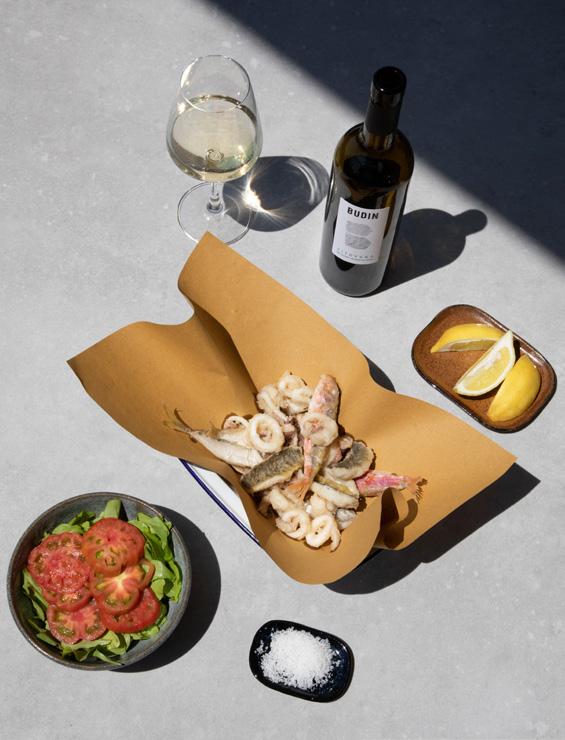
C. Bach 56 IES, TRIESTE LIFESTYLE N°21 — Summer 2023 Città da gustare
The sea is served
Trieste è il mare, d’estate ancor di più. Il triestino lo vive tutto l’anno, ma la magia di un pescato del golfo gustato guardando “ el mar che lusiga ” (che luccica) è un’esperienza irrinunciabile in questa città.
Con la porta spalancata sull’estate ci viene naturale parlarvi del fritto misto. Piatto che esalta i sapori del pesce freschissimo, di stagione e locale. Ma quali sono questi pesci? Cosa c’è d’estate nel nostro mare?
Un mare fragile nelle parole di Maurizio Spoto, Direttore Area Marina Protetta di Miramare presso WWF Oasi, che ha reso “difficilissimo dare indicazioni su quali pesci siano più sostenibili a lungo termine” perché gli ecosistemi ormai sono in continuo cambiamento. “Adesso andrebbero predilette le specie ai livelli più bassi della catena alimentare, erbivore, come salpe e cefali, le specie invasive ed i mitili.” E non dovremmo sorprenderci se, in futuro, le meduse entrassero a far parte dei menù dei ristoranti (a dire il vero, chef stellati lo stanno già facendo).
Il concetto di base è che se si ha a cuore il futuro bisogna cominciare a non scegliere sempre i soliti pesci. I sardoni barcolani sono un esempio lampante, ormai sempre più piccoli e sempre più difficili da trovare. Buonissimi, certo, e parte della nostra identità culinaria, ma ci sono vere delizie meno conosciute ma non a rischio che a volte vengono addirittura ributtate in mare perché fuori mercato.
Tra i tanti progetti il GAC FVG (Gruppo di Azione Costiera) e il WWF lavorano in collaborazione con i piccoli
pescatori artigianali del territorio, un patrimonio da preservare per tenere vivo il rapporto magico tra mare, uomo e cucina. L’Area Marina Protetta di Miramare a settembre 2023 chiuderà uno studio sulla tutela biologica dell’area antistante la costa, fatto assieme ai professionisti della piccola pesca tradizionale eseguita con reti da posta e nasse. Il progetto, spiega Maurizio Spoto, include attività di formazione con i pescatori, educative presso le scuole e una sensibilizzazione dei consumatori e degli stakeholder della filiera.
In sintesi, per i pesci giusti affidatevi ad un pescivendolo di fiducia che abbia a cuore il futuro del nostro mare come Claudio, in Via di Cavana 13c, tanto per fare un esempio. Che vi suggerirà i suri (o sugarelli), la papalina (detta anche saraghina o spratto), i cefali, qualche calamaretto (più a fine estate, ancor di più in ottobre) e una manciata di seppie che a inizio estate abbondano rappresentando un’ottima alternativa al calamaro.
E con questo sacchetto di tesori lasciatevi sorprendere preparando la nostra ricetta.
Il fritto misto esalta i sapori del pesce freschissimo, ed è quindi da immaginare con il pescato del giorno.
Fried fish truly brings out the best of freshly caught seafood and should always include the catch of the day.
di /by Alice Fabi
tavola
foto di /photo by Camilla Bach
Il mare in
57 IES, TRIESTE LIFESTYLE N°21 — Summer 2023 Taste the city
Trieste means seaside, especially in summer. Triestini live “their” sea all year round, and yet they never miss a chance to taste freshly-caught Gulf seafood with a view of “el mar che lusiga” (Triestine dialect for “the sea that glistens”) – it is pure magic and a real must in this city.
There is no summer without fritto misto: a dish bringing together a variety of fried fish that truly brings out the best of local freshly caught seafood of the season. Which brings us to our next point: what does Trieste’s sea offer in the summer months?


According to Maurizio Spoto, Director of WWF Oasis Area Marina Protetta (i.e., Marine Protected Area) of Miramare, “this fragile sea makes it quite difficult to identify long-term sustainable fishing varieties”, especially owing to the ever-changing nature of ecosystems: “as a general rule, summer is the time for species identified as the bottom of the food chain, mainly herbivores, such as dreamfish and mullet, as well as invasive varieties and mussels”. Furthermore, we may soon expect jellyfish to be featured in restaurant menus (some top chefs have already introduced them in theirs).
The basic concept here is that the future of the environment depends heavily
Il concetto di base è che se si ha a cuore il futuro bisogna cominciare a non scegliere sempre i soliti pesci.
ENGLISH TEXT
The basic concept here is that the future of the environment depends heavily on our fish-eating choices.
C. Bach C. Bach 58 IES, TRIESTE LIFESTYLE N°21 — Summer 2023 Città da gustare
LA RICETTA
Fritto Misto
Per 4 persone
600g pesci di piccola taglia: suri, papaline, cefali
500g seppie e/o calamari
200g farina tipo 0
1lt olio d’arachidi
300g ‘radicio’ - cicoria zuccherina triestina
4 pomodori grandi olio extravergine d’oliva sale e pepe
aceto di vino (consigliamo quello d’uva di Sirk) o limone
Far pulire il pesce al pescivendolo, lavarlo e asciugarlo bene. Passare nella farina prima di friggere nell’olio di semi o arachidi (consigliato per il punto di fumo più alto). Fondamentale la temperatura (180°) e non ammassare il pesce: friggere piccole quantità, e asciugare su abbondante carta assorbente tenendoli ben distanziati. Il tempo di cottura dipende dalla taglia del pesce, lasciatevi guidare dal colore che dev’essere dorato. Salare e mangiare ancora caldo. Ricordarsi di smaltire l’olio correttamente.
Consigliamo vicino un’insalata di pomodori e ‘radicio’. La tradizione vorrebbe “radicio e fasoi”, ma visto che la proteina è già nel pesce perché non un bel pomodoro di stagione al posto dei fagioli, che porta freschezza al piatto e pulisce il palato con la sua acidità?
Condire con EVO, sale, pepe ed aceto.
In abbinamento proponiamo una vitovska del Carso, minerale e fresca, ricordando due manifestazioni imperdibili dedicate ai bianchi autoctoni del territorio: Mare e Vitovska (30 giugno - 1 luglio) nel castello di Duino e Malvasia in Porto (29 Luglio) a Porto San Rocco.
Serves 4
600g / ca. 1.5 pounds smallsize fish: suri (horse mackerel), papaline (sprat), mullet

500g / ca. 1 pound cuttlefish
and/or squids
200g / ca. 1 cup type-0 flour
1lt / ca. 4 cups peanut oil for frying (higher smoke point than vegetable oil)
300g (1 tuft) ‘radicio’ – Trieste Sweet sugar chicory
4 large tomatoes
extra-virgin olive oil
salt and pepper
white wine vinegar (we recommend wine vinegar from Sirk grapes) or lemon juice
Have your trusted fishmonger clean your fish. At home, wash under running water and dry thoroughly. Dip seafood into the flour. Pour peanut oil into a large pan and heat to 180o C (356o F). Fry battered seafood in small batches until crisp and lightly golden (frying time may vary depending on the kind of seafood). Lay on a towellined surface (fish should not overlap) and let drain.
Season with salt and serve hot. Remember to properly dispose of used frying oil.
Now focus on the side dish of tomato & radicio salad. This recipe usually features “radicio e fasoi” (Triestine dialect for chicory and beans), but since fish is already rich in proteins, why not replace beans with something seasonal, like tomatoes, which bring a touch of freshness to the dish and cleans the palate with their acid components? Pour all ingredients in a large bowl and season with extra-virgin olive oil, salt, pepper, and white wine vinegar.
Our wine suggestion is a glass of Karst Vitovska, dry and very mineral.
If you wish to learn more about local white wine, you may consider the following events: Mare and Vitovska (30th June – 1st July) at Duino Castle; and Malvasia in Porto (29th July) in Porto San Rocco.
on our eating choices. Witness the case of Barcola’s sardoni: a real palate-pleaser and flagship of Trieste’s cuisine, this variety of European pilchard is growing smaller and rarer every year – while other non-endangered, equally tasty, yet less known local delicacies are thrown back into the sea simply because there is little or no market demand for them.
The regional Coastal Action Group − GAC FVG and the WWF are spearheading numerous environmentally friendly projects, working side by side with small local fishing businesses, which are a crucial chain link between people, sea, and food. In September 2023 Miramare’s Area Marina Protetta is completing a study on the Biological Protection Zone of Miramare’s inshore waters, in cooperation with local fishing businesses still applying traditional fishing methods, such as driftnets, pots, and creels. Maurizio Spoto explains that the study is part of a larger project that includes training activities for fishing businesses, education workshops for schools, and awareness-raising campaigns addressing industry stakeholders and general public.
To sum up, when looking for the right kind of fish, rely on your local trusted fishmonger and their concern for the future of our sea – one like Claudio. When you visit his shop in Via di Cavana 13c, you can entrust yourself to him: suri or sugarelli (horse mackerel), papalina (sprat) – also known as saraghina or spratto, mullet, a handful of baby squids (mainly at the end of the summer and in October), and cuttlefish – abundant in summer months and a perfect alternative to squids.
Once you have picked up your bag of treasures, have a go at our recipe and prepare to be amazed.
C. Bach 59 IES, TRIESTE LIFESTYLE N°21 — Summer 2023 Taste the city
di /by Alberto Polojac
Esplorando i metodi di preparazione all’aria aperta
Discovering coffee brewing methods ‘al fresco’

Molto spesso quando viaggiamo, trovare un buon caffè a portata di mano può diventare un’impresa quasi epica. Per questo Bloom Specialty Coffee ha pensato a delle soluzioni facili e pratiche che possano permettervi di non rinunciare all’abitudine di un caffè di qualità eccelsa anche nei posti più impensabili. Alla base della “filosofia
Bloom” infatti, c’è non solo un caffè con una descrizione dettagliata e minuziosa, fatto sulla misura delle proprie preferenze di gusto, ma anche e soprattutto un prodotto che possa essere alla portata di tutti e sempre disponibile.
Tra i prodotti di Bloom Specialty Coffee, potrete trovare non solo caffè di alta qualità con una vasta selezione di chicchi provenienti da tutto il
BREAK CAFFÈ CON VISTA
60 IES, TRIESTE LIFESTYLE N°21 — Summer 2023 Contributors
mondo, coltivati con cura e tostati con maestria. Presso la sede di Campo del Belvedere a Trieste, sono disponibili una varietà di opzioni per la preparazione fuori da casa e all’aria aperta, illustrate con estrema cura da un team di esperti del settore che vi potranno guidare nella scelta.
Un vero cultore della bevanda deve sempre avere con sé gli strumenti adatti. Inoltre, l’attrezzatura portatile per la preparazione del caffè offre comodità e facilità d’uso. Una sorta di kit di sopravvivenza per i viaggiatori che sono sempre alla ricerca di modo rapido ed efficiente per poter preparare caffè per loro e condividerlo con chi sta intorno. Iniziando da un macinatore manuale, perché il piacere di un caffè preparato come si deve prevede una macinatura eseguita sul momento. Ne esistono di diversi modelli, pratici e maneggevoli, per ogni fascia di prezzo, leggeri e facili da trasportare. Un vero e proprio compagno di viaggio che rispecchia uno spirito curioso e intraprendente e connette con il caffè in un modo speciale e unico, aggiungendo un rituale intimo e ineffabile alla semplice preparazione della bevanda.
Nell’infinito panorama dei metodi di preparazione con vista, si apre un universo di opzioni, un mare di alternative, un’ode all’arte e alla creatività che si manifesta attraverso strumenti affascinanti, dai più moderni a quelli tradizionali. Ogni strumento porta con sé la promessa di una tazza unica, un’opera d’arte gustativa che rispecchia la personalità di chi la crea.
È l’acqua calda? Vi chiederete. Se non è possibile portare con sé un thermos per trasportare dell’acqua, è possibile utilizzare anche acqua fredda per assaporare un cold brew fatto interamente con le proprie mani.
Così, sulle rive del mare, il caffè diventa più di una semplice bevanda. È un rituale di connessione con il presente, un viaggio sensoriale che coinvolge l’anima e riscopre la gioia dei piccoli piaceri. Senza dimenticare che questo viaggio nel viaggio ci permette di stare a stretto contatto con la materia prima e di chi la produce, in perfetta armonia con l’ambiente circostante, senza utilizzare energia elettrica, ma solo quella meccanica delle nostre mani.

È la celebrazione di un momento fugace e un’ode alla bellezza della vita. Parola di Bloom!
Finding good coffee when travelling may often turn into a daunting task. Bloom Specialty Coffee comes to its patrons’ assistance with a range of simple and convenient solutions to enjoy top-quality coffee even in the most unusual situations. This is “Bloom’s philosophy”: not only a detailed description of every item in their excellent coffee selection and an experience tailored to each individual taste, but also complete accessibility and availability of their products.
Bloom Specialty Coffee is already renowned for its world-wide selection of high-quality beans, cultivated with great care in their countries of origin and then skilfully roasted by Bloom’s coffee virtuosos. Now, Bloom’s shop in Campo Belvedere, Trieste, offers a whole series of travel kits for outdoor coffee making, promptly illustrated by Bloom’s expert staff, who are always ready to help customers find the set that best suits their needs.
True coffee lovers need the best possible gear, and coffee-brewing portable kits are easy to use and offer unprecedented comfort – in other words, they will soon become
essential, the ultimate survival kit for travellers who wish to be able to enjoy and share good coffee anywhere. The basic package must include a hand grinder, because good coffee tastes best when freshly ground. Hand grinders come in various shapes and sizes, there is one for every price range, and each is very practical, light, and easy to carry: the ideal travel companion for adventurers and wayfarers, who can still enjoy the cosy feeling of coffee-making while on the road.
Coffee with a view is not a mere expression: it is a whole world, with countless options and alternatives, celebrating the art of coffee making through a vast array of fascinating tools, from the most traditional ones to the latest inventions. Each item carries the promise of a unique tasting experience, an artwork in a cup, displaying the unmistakeable signature of its author.
What about hot water?, you may ask. When a vacuum flask is not an option, you can use cold water to make your own cold brew.
Here on the seashore coffee becomes more than a beverage: it is a ritual connecting to the here and now, but also a journey of the senses that brings back the joy of small things to the soul. This journey within a journey leads travellers to coffee beans and blend producers, following an itinerary that is eco-friendly and sustainable, as the only power it requires is the sheer mechanic force of human hands.
It is the celebration of a fleeting moment and an ode to the beauty of life. Word of Bloom!
ENGLISH TEXT
61 IES, TRIESTE LIFESTYLE N°21 — Summer 2023 Contributors
WE ARE
AL BAGNO COME STILE DI VITA
Il mare è vacanza, profuma di estate per antonomasia. A Trieste però andare al bagno, come si dice in gergo è un vero e proprio stile di vita.
In questo caso la donna triestina affronta con disinvoltura un’alta dose di compromessi. Prima di tutto con il territorio. A Trieste il sole si prende con un telo sul cemento di Barcola, sui ciottoli del Pedocin o in versione integrale al Solarium per sole donne dell’Ausonia e ci si gode il tramonto in equilibrio sul moletto di qualche porticciolo.
Ci si tuffa arrampicandosi su uno scoglio, o scendendo giù per sentieri impervi che partono dalla costiera e s’infilano fra i cespugli. Solo più raramente dalla comoda scaletta di una spiaggia attrezzata.
Poi c’è lo stile di vita. Trieste è una città di mare, non è un luogo di villeggiatura in cui rilassarsi troppo rinunciando a un abbigliamento urbano.
Certo, ci sono giornate di ferie o del week-end in cui rigirarsi al sole godendosi tutte le comodità di uno stabilimento balneare, espresso con schiuma di latte fredda all’ombra di una pergola incluso, ma è più probabile che il mare rappresenti per la Triestina doc una piacevole pausa nel tran tran quotidiano: un’ora irrinunciabile di sole in pausa pranzo o un toc al tramonto, uno spritz, bianco e morbido, prima di andare a cena in Osmiza, o un infuso fresco al gusto di paradisi tropicali.
Immancabile poi la barca, spesso ancorata vicino a riva o ormeggiata in uno dei tanti circoli nautici della città, da cui partire per una giornata intera o in cui rilassarsi per un paio d’ore gustando un buon bicchiere di vino. Ecco perché la borsa della donna triestina dev’essere comoda e capiente quanto basta per custodire non solo crema e costume, ma anche una serie di oggetti inaspettati, piccoli e grandi preziosità da tirare fuori al momento giusto come da un forziere, qualunque sia lo stile del bagno che si abbia
di /by Stefania Boccabianca
Coach e consulente, appassionata di brand ama scoprire piatti, locali e prodotti sempre nuovi. Non resiste alla cucina etnica e al cioccolato fondente.
Quale aspetto di Trieste ti piacerebbe fosse approfondito? Mandami un appunto, grazie!
Scrivi a:
stefania.boccabianca@gmail.com

Si ispira al design scandinavo e al minimalismo giapponese il cesto fatto in Ghana di Muun Etre Concept Store, Via della Pescheria 13a.

1
OPEN
62 IES, TRIESTE LIFESTYLE N°21 — Summer 2023 Città da vivere
2 3
4 6


Morbido, fresco e profumato, il vino dal carattere espressivo proprio come Fiori di Campo è ideale per un aperitivo in barca al tramonto. Royal Bar, Via Giosuè Carducci 12a.
Mantiene qualsiasi bibita fresca fino a 24 ore la bottiglia Chilly’s da portare sempre con sé, si sposa con (5) l’infuso alla frutta a base di mela, papaya e scorze di limone che si prepara direttamente in acqua fredda. PETER’S Tea House, via Dante Alighieri 2a.

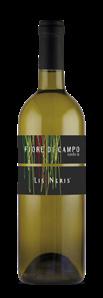
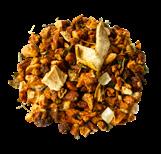
il Foulard 100% lino, ampio e leggero, ha i colori del mare e degli alberi costieri ed è disponibile in esclusiva negli store di Trieste e Bologna.

Neirami, Via Felice Venezian 7b.
Policarbonato bianco per il calice dal deign inconfondibile di Italesse, ideale per spiagge, barche e giardini.

ITALSTORE, Via Mazzini 32.
 The Happy feet Club, Via Mazzini 53.
The Happy feet Club, Via Mazzini 53.
5
7
63 IES, TRIESTE LIFESTYLE N°21 — Summer 2023 Live the city
PALMANOVA VILLAGE: TERRA DI STORIA E DI SHOPPING
Palmanova Village: Land of History and Shopping
C’è un luogo che è una tappa fondamentale per chi ama lo stile e la moda. Immerso nella natura, a pochi chilometri dalle colline del Collio e dalle città UNESCO Palmanova, Aquileia e Cividale del Friuli, c’è Palmanova Village. Con i suoi 90 negozi dei migliori marchi internazionali -di abbigliamento, accessori, casa e molto altro ancora– Palmanova Village propone riduzioni fino al 70% tutto l’anno. Molte le griffe presenti al Villaggio: i brand che si rivolgono ad un pubblico giovane e modaiolo come Alberta Ferretti - Moschino, Iceberg – Ice Play – Paolo Pecora – Siviglia, Flavio Castellani, Guess, Tommy Hilfiger, Ixos, Desigual, Calvin Klein, Levi’s, Liu Jo Uomo e che si alternano lungo le vie del Villaggio e a negozi di taglio più tradizionali quali Enrico Coveri, Facis, Harmont & Blaine Jeans, Lanificio Angelico, Hermitage. Ottima
la scelta nell’abbigliamento sportivo e per il tempo libero: Nike, Adidas, Puma, General Store – Timberland, North Sails, CMP, Kappa, Salewa e Slam. Un capitolo a parte meritano gli store di calzature, borse e valigie, garanzia di qualità e Italian style: Pollini, Piquadro – The Bridge, Baldinini e Roncato. Tra un acquisto e l’altro, tra i tanti punti ristoro e bar del Villaggio, suggeriamo una tappa rinfrancante tra l’originale Italian Excellence - Prosciutteria ristorante, dedicato alle tipicità enogastronomiche del territorio, e Hamerica’s, punto di riferimento per il burger gourmet in Italia o a La Piadineria. Il Villaggio offre numerosi servizi alla clientela tra cui un’area giochi a misura di bimbo, un ampio parcheggio, il wi-fi gratuito e la ricarica veloce “fast charge” per le auto elettriche.

Il Villaggio è aperto 7 giorni su 7, dalle 10 alle 20, festivi compresi.

SHOP
64 IES, TRIESTE LIFESTYLE N°21 — Summer 2023 Contributors
There is a place which is a fundamental stop-over for fashion and style addicted. Surrounded by nature, just a few km far from the sweet hills of Collio, from the UNESCO cities of Palmanova, Aquileia and Cividale del Friuli there is Palmanova Village.


With its 90 shops of the most fashionable brands – of clothes, accessories, homeware and even more – Palmanova Village offers discounts up to 70% off all year round. Many are the brands available in the center: young and trendy brands such as Alberta Ferretti - Moschino, Iceberg – Ice Play – Paolo Pecora – Siviglia, Flavio Castellani, Guess, Tommy Hilfiger, Ixos, Desigual, Calvin Klein, Levi’s, Liu Jo Uomo, alternated in the Village to most traditional shops such as Enrico Coveri, Facis, Harmont & Blaine Jeans, Lanificio Angelico, Hermitage. The choice of sportswear and casual clothes is excellent: Nike, Adidas, Puma, General Store –Timberland, North Sails, CMP, Kappa, Salewa e Slam. Our footwear and accessory stores deserve a special mention since the brands are guarantee of quality and Italian style: Pollini,
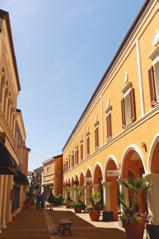
Piquadro – The Bridge, Baldinini and Roncato. We suggest on spending a break among the purchases at the particularly original Italian Excellence - Prosciutteria ristorante, a space entirely dedicated to typical wine and food of Friuli, or at Hamerica’s, a benchmark for the gourmet burger in Italy, or at La Piadineria. The Village offers several services to guests such as the playground area, tailor-made for kids, a large car park, free wi-fi connection and the “fast-charge” for electric cars.
The Village is open 7 days a week, from Monday to Friday 10 a.m. – 8 p.m., also on public holidays.
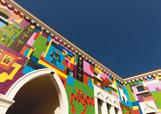
Palmanova Village
SP 126 Km 1.6 – 33041
Joannis di Aiello del Friuli (UD)
T: +39 0432 837810
www.palmanovavillage.it
info@palmanovavillage.it
ENGLISH TEXT
INFO
65 IES, TRIESTE LIFESTYLE N°21 — Summer 2023 Contributors
LOCAL GUIDES
di /by Micol Brusaferro
Una piccola perla tutta da scoprire
A true gem of the Gulf
MUJA!
Una passeggiata tra le calli pittoresche del centro storico, un caffè in piazza Marconi, un pranzo nei tanti ristorantini di pesce sparsi in tutta la città e poi un tuffo sul lungomare o un aperitivo al tramonto. Muggia è una piccola perla che soprattutto d’estate dà il meglio di sé.

Cosa fare a Muggia
Perdersi nelle calli Camminando soprattutto nella zona vicino al castello, dove alcune viuzze regalano scorci unici, grazie alle decorazioni e ai fiori posizionati con cura dai residenti e dove si possono scorgere anche cortili e giardini nascosti.
Fermarsi in piazza Marconi
Il cuore della città, dove si trova il Duomo, il Municipio e tanti caffè, ideali per un drink nell’arco di tutta la giornata. Qui si ritrovano anche molti turisti, ciclisti in particolare, che poi proseguono per lunghi tragitti come la Parenzana.
Visitare il castello
Domina la città e il porticciolo, una dimora privata, ma aperta al pubblico, anche per pernottamenti. Un maniero che al suo interno svela un volto straordinario. Le informazioni si possono ricevere scrivendo a info@castellodimuggia.com
Scoprire una delle collezioni private su Beethoven più ricche al mondo.
Si tratta del museo della famiglia Carrino, allestito in un’abitazione della città, dove si possono ammirare migliaia di oggetti e tantissime curiosità. Basta inviare una mail a lvb@bibliotecabeethoveniana.it.
Mangiare un piatto di pesce
Mangiare un piatto di pesce nei tanti ristorantini della città che offrono una vasta scelta di proposte, abbinate spesso a vino e olio del territorio, oltre ad altre specialità tipiche. Un’opportunità valida anche per un drink e una degustazione al tramonto.
Salire fino a “Muggia Vecchia”
Dove scoprire il parco archeologico e la splendida chiesetta antica, la
66 IES, TRIESTE LIFESTYLE N°21 — Summer 2023 Fuori porta
basilica di Santa Maria Assunta, immersa in un’area verde. Qui si trova anche uno dei punti panoramici più belli della città.
Partecipare al Carnevale estivo
Partecipare al Carnevale estivo che persegue la tradizione muggesana del Carnevale e la sua celebre parata di carri allegorici; si svolge nelle prime settimane d’agosto, con chioschi, musica, una curiosa regata sul mare con mezzi coloratissimi (Vogatamata), una corsa tra le vie del centro tra giochi e intrattenimenti (Carnival run).
Seguire l’ampia offerta culturale Tra il Museo Carà, la Biblioteca Edoardo Guglia e il Teatro Verdi, che durante tutto l’anno ospitano festival, rassegne, concerti ed eventi speciali. Il programma è sempre aggiornato su muggiacultura.eu.
Godere sole e mare
Nella zona di Aquario, il lungomare attrezzato dove sono presenti diversi locali, ma anche campi di beach volley, uno skatepark e altri spazi che coniugano sport, divertimento e relax.
A stroll through the evocative maze of narrow alleys; a cup of coffee sitting in Piazza Marconi; a seafood lunch in one of the countless little restaurants and taverns scattered throughout the oldtown; a swim alongside the seafront; or an aperitif at sunset: Muggia is a gem that shines at its brightest in the summer months.
Things to do in Muggia
Wander about and get lost in the maze of alleys that extends within the shadow of the castle Enjoy the sights, smell the flower decorations set up by the townspeople, and catch a glimpse of hidden courtyards and secluded gardens.

ENGLISH
TEXT
Muggia dà il meglio di sé nella stagione estiva.
Muggia is at its best in the summer season.
67 IES, TRIESTE LIFESTYLE N°21 — Summer 2023 Outside the city
M. Zocchi
Head towards Piazza Marconi
The very heart of Muggia, with the Duomo and the townhall; look around at the ample choice of delightful cafés serving drinks and beverages all day long, and take your pick – you cannot go wrong. Patrons usually include a good share of tourists, especially bicycle riders, enjoying a quick snack before setting off for one of the local cycling routes, like the Parenzana.
Visit the castle
Perched on the cliff overlooking the town and the marina: the current owners keep it open to the public for tours and overnight stays. A great opportunity to visit an extraordinary manor. For further questions, you may send your inquiries to the following address: info@ castellodimuggia.com
Find out about one of the world’s largest private collections on Beethoven
Carrino family’s townhouse hosts a full-fledged museum collecting historical and artistic testimonies, anecdotes, and curiosities. To visit Biblioteca Beethoveniana, contact lvb@bibliotecabeethoveniana.it.
Taste excellent local seafood
Taste excellent local seafood in one of Muggia’s cosy restaurants: alongside a wide selection of seafood courses, guests may often sample local wines and oils, as well as other traditional delicacies. During happy hour (usually at sunset) drink orders include a serving of mouth-watering snacks.
Follow the road leading uphill to “Muggia Vecchia” (i.e., old Muggia), Where you can find an archaeological park and a little ancient church: it is the beautiful basilica of Santa Maria Assunta, now the parish church of Muggia Vecchia, surrounded by nature. Up here there is also one of Muggia’s best panoramic viewpoints.
Join in the celebrations of the summer Carnival
Join in the celebrations of the summer Carnival, following up Muggia’s tradition of winter Carnival and its famous parade of carnival floats. The summer Carnival takes place in the first half of August, with stands, music, a peculiar regatta of colourful watercrafts known as Vogatamata, and a crazy race through town, the Carnival run, complete with games and entertainment.
Enjoy Muggia’s cultural destinations

Enjoy Muggia’s cultural destinations: the Carà Museum, the library “Biblioteca Edoardo Guglia”, the Verdi Theatre, hosting festivals, shows, concerts, and special events all year round. Full programme and updates available at www.muggiacultura.eu.
Relax, sunbathe, and take a swim in the Aquario area
Relax, sunbathe, and take a swim in the Aquario area, Muggia’s seafront with beach services and numerous cafés and lunch bars; adjacent to the seafront visitors will also find beach volley fields, a skatepark, and further sports, relaxation, and entertainment areas.
‘Aquario’, lungomare attrezzato per sport e relax.
‘Aquario’, waterfront facilities for sports and relaxation.
68 IES, TRIESTE LIFESTYLE N°21 — Summer 2023 Fuori porta

Trattoria ‘Al Castello’
Seafood in a friendly atmosphere
CASTELLO’ CUCINA DI MARE IN UN POSTO FAMILIARE
Dal Duomo, con la sua caratteristica facciata trilobata, fino al Museo Carà, che ospita mostre d’arte di grande interesse, dal parco archeologico intorno all’antico Santuario, fino alla Biblioteca Beethoveniana, unica al mondo, sono tante le buone ragioni per visitare Muggia. A queste aggiungiamo un’altra attrazione da scoprire. Anzi, da gustare. È la Trattoria al Castello, un ottimo pretesto per venire e per ritornare nella bella località del litorale triestino. Un’idea luminosa, proprio come la luce che entra negli ampi spazi del locale.
La Trattoria al Castello, nella location attuale, nasce nel 1992 grazie a Breda e Miro, ai quali negli anni si è affiancato il figlio Alessandro.
Oggi la tradizione di famiglia continua con Alessandro e la moglie Lorella. Ed è proprio lei a fornirci la migliore definizione del locale, telegrafica ma di grande efficacia: “Trattoria con cucina tradizionale, pesce fresco e ambiente familiare!”
Il mare effettivamente la fa da padrone nel menù, che vanta come piatto forte i sardoni in savor, senza spine, preparati seguendo la ricetta della signora Breda, un’eredità culinaria che Lorella e il marito onorano con devozione e con il grande aiuto di tre giovanissimi Chef, di cui vanno molto fieri. Si chiamano Samuele, Chiara e Riccardo, con il loro talento e la loro passione cercano di dare un’impronta nuova in cucina, conservando sempre il rapporto con semplicità, territorio e genuinità.
Ma la lista delle proposte offre un “golfo” di specialità, dagli antipasti in poi: canoce bollite, folpi in insalata,
sardoni marinati, cozze a scottadito, gransevola aggiungendo negli ultimi anni anche piatti di pesce crudo. Tra gli highlights della trattoria muggesana spiccano le zuppe di pesce e i fusi fatti in casa conditi con il “granzoporo”. Tra i primi, primeggiano, la zuppa di scorfano, il risotto alla marinara e gli spaghetti alle vongole.

Il fritto misto qui si fa leggero ed è una garanzia, così come i sardoni impanai, la tagliata di tonno e il pescato del giorno, grigliato, al forno o al sale.
Una bella veranda, 2 belle sale, e tanta luce!
La Trattoria Al Castello ha tutti i numeri per allietare pranzi, cene e occasioni speciali, feste, matrimoni, i banchetti più svariati. Ambienti accoglienti, con l’eleganza sobria della classica trattoria
di famiglia. Tradizione sì, ma anche nuove idee: serate musicali e coinvolgenti eventi a tema, dalle paellate, alle cene con delitto che diventano un diletto.
Il mare è protagonista anche del panorama che si può godere da quassù, a 5 minuti dal centro della cittadina, inerpicandosi per la salita che inizia di fianco alla galleria. La Trattoria al Castello è facile da raggiungere in auto e offre un ampio parcheggio. Ci si può arrivare anche a piedi per essere pienamente ripagati della fatica una volta seduti a tavola.
Senza dimenticare che a Muggia di giorno è bello arrivare anche con il Delfino Verde, la motonave che tutto l’anno collega Trieste alla cittadina istroveneta, per un’esperienza di mare al 100%. Lunga vita ai luoghi come questo!
FOOD ‘AL
70 IES, TRIESTE LIFESTYLE N°21 — Summer 2023 Contributors
From the Duomo, with its traditional three-foiled façade, to the Carà Museum, hosting highly praised art exhibitions; from the archaeological park surrounding the ancient Santuario, to the one and only library “Biblioteca Beethoveniana” …there are so many good reasons to visit Muggia. And we would like to contribute to the list with one more – one that will delight your palate. Trattoria al Castello is in itself a perfectly good reason to visit, or return to, this beautiful spot on the coast of Trieste’s Gulf. A brilliant idea – just as brilliant as the bright light that permeates the ample rooms of the restaurant.
Trattoria al Castello in its current location was inaugurated in 1992 by Breda and Miro, later joined by their son Alessandro. Today the family business is in the hands of Alessandro and his wife Lorella. The latter came up with the perfect formula to describe the place: “Trattoria with traditional cuisine, fresh seafood, and friendly atmosphere!”
Indeed, seafood is featured quite prominently in the menu, where the specialty is sardoni in savor – sardine (pilchard) steaks that are boned, marinated, and then fried. At al Castello they are prepared and served following signora Breda’s recipe: her culinary legacy is honoured everyday by Lorella and her husband, with the invaluable help of their three young chefs Samuele, Chiara, and Riccardo. Alessandro and Lorella are quite proud of their chefs’ talent and
passion, and their ability to strike the right balance between innovation, tradition, territory, and wholesomeness.
The rest of the menu features mostly Gulf’s delicacies, from the appetizers onwards: boiled canoce (slipper lobster), folpi in insalata (octopus’ salad), marinated sardoni, mussels scottadito, gransevola (a term that originates from the dialect granso, i.e., crab, and seola , i.e., onion), and, more recently, raw fish dishes.
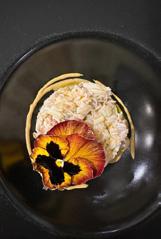
Further highlights include fish soup, fish stew, and the Trattoria’s own homemade fusi pasta with “ granzoporo ” (Triestine dialect for brown crab). Other famous main courses are rockfish soup, risotto alla marinara, and spaghetti with clams.
Fried fish here is extremely light and invariably tasty, just like sardoni impanai (i.e., breaded and fried), tuna fish steak, and the catch of the day, which is served grilled, roasted, or salted.
A beautiful veranda, two spacious rooms, and a lot of natural light!

Trattoria al Castello is the perfect spot for your lunch or dinner, special occasions, parties, weddings, and more. A welcoming space, elegant and sober: the classic family trattoria. With a twist

of innovation: music nights, exciting themed events, paella days, and murder mystery parties – where crime is exceptionally tasty.
Up here the view on the sea is truly majestic – at a mere 5-minute uphill drive from the town centre, following the alley next to the tunnel. Trattoria al Castello may be easily reached by car (ample parking lot available) or on foot, for those who wish to earn their meal.
During the day visitors can travel by sea and enjoy a “full sea experience” on board the motor vessel Delfino Verde, connecting Trieste to Muggia all year round. Long live our trattorias!
ENGLISH TEXT
INFO Salita delle Mura, 11 Muggia +39 040 272667 +39 340 40 96 716 info@trattoriaalcastello.net FB @trattoriacastellomuggia 71 IES, TRIESTE LIFESTYLE N°21 — Summer 2023 Contributors
Ways of sea and stone
SENTIERI DI MARE E DI PIETRA

72 IES, TRIESTE LIFESTYLE N°21 — Summer 2023 Fuori porta
Il fascino di Aurisina, paese incastonato sul Carso triestino, è la sua intima relazione tra il borgo e il mare.
A cominciare dal prezioso calcare, il “marmo” sul quale e con il quale è costruita, custode di una moltitudine di organismi marini fossili.
La sua pietra bianca, estratta dalle cave millenarie, non solo caratterizza case, ornamenti, pozzi del paese, ma è stata impiegata in tutto il mondo, raccontando una storia di opere celebri. È suggestivo pensare che la maestosa cupola del Mausoleo di Teodorico, il Parlamento di Vienna e altri capolavori in Europa e nel mondo custodiscano le tracce di un mare antichissimo.
Oggi, come un tempo, per arrivare al mare da Aurisina bisogna percorrere l’antico Sentiero dei Pescatori, a ricordarci che in paese al duro lavoro dei cavatori di pietra e dei contadini si affiancava una fiorente attività di pesca.
Ci vogliono quasi cinquecento gradini, tra pastini di ulivi e vigneti, per raggiungere la spiaggia sassosa di Canovella de’ Zoppoli, ma la fatica del percorso è ampiamente ripagata dal panorama, che abbraccia il Golfo di Trieste, Grado e la costa istriana. La spiaggia, di una bellezza selvatica, deve il suo nome alle caratteristiche imbarcazioni monossili, ritagliate da un unico grosso tronco d’albero, dette appunto zoppoli o čupe.
Un altro gioiello che merita una visita è il Museo della Pesca - Ribiški Muzej di Santa Croce, caratteristico borgo carsico sulle alture di Trieste. Per raggiungere il museo si percorre un dedalo di viuzze tra casette e cortili, che con amore e cura per le tradizioni, gli abitanti del paese

Sull’altipiano carsico triestino, Aurisina e Santa Croce raccontano storie di pesca, di mare e di pietra.
di /by
73 IES, TRIESTE LIFESTYLE N°21 — Summer 2023 Outside the city
Up on Trieste’s Karst Plateau Aurisina and Santa Croce narrate stories of fishing, of stone, and of the sea.
Maddalena Giuffrida
stanno riportando all’antico splendore.
La vista spettacolare che si gode da questo museo etnografico dedicato al Litorale triestino rende il luogo davvero unico. Al suo interno sono conservati gli antichi attrezzi da pesca, i documenti e le foto che illustrano la storia millenaria e la vita quotidiana dei pescatori, accanto a quella delle donne del pesce, le peškadorke.
E a Santa Croce si ricorda ancora la spettacolare pescata di tonni del 1954, quando in una sola volta se ne catturarono ben ottocento. La pesca di tonno è stata la principale attività per i pescatori di questo Litorale, da Barcola a Santa Croce e Aurisina, e le tonere, le imbarcazioni usate per tale pesca, sono state attive nel Golfo di Trieste fino alla metà degli anni Cinquanta.
Per ritornare ad Aurisina, da Santa Croce non si può mancare il Sentiero della Salvia, un suggestivo percorso panoramico di quasi tre chilometri, riparato dai venti, che costeggia il ciglione carsico. Ad accompagnare il cammino, il profumo della salvia e, naturalmente, l’incantevole vista sul mare.
The charm of Aurisina, little hamlet nestled within the Karst riff, and its connection to the sea –starting with precious limestone, the hamlet’s “marble” and depository of countless marine fossils.
The pure white of this stone, mined from centuries-old quarries, clads house walls, decorations, and wells all over town. And beyond: it may come as a surprise to learn that famous buildings, such as the majestic dome of the Mausoleum of Theodoric in Ravenna and the Austrian Parliament Building in Vienna, just to name a few, hide within their walls the traces of an ancient sea.
Today, just like in the days of old, the only way to access the sea from Aurisina is through the old Sentiero dei Pescatori (i.e., fishermen’s path), as fishing was an integral part of the town’s economy, together with limestone quarrying and farming.
Almost five hundred steps winding down the slope of olive tree groves and vineyards lead to the pebbled shore of Canovella de’ Zoppoli: a difficult descent, but every effort is repaid by the wild beauty of the little inlet and the
breath-taking view over the Gulf, as you let the gaze roam free, all the way to Grado and the Istrian coastline. The shore is named after local fishing vessels: boats carved out of single tree trunks known as zoppoli, or čupe.

Another place worth a visit is “Museo della Pesca – Ribiški Muzej” (i.e., museum of fishing) in Santa Croce, a classic Karst borgo uphill from Trieste. A web of alleyways twists and turns through houses and little yards, that Santa Croce’s inhabitants lovingly tend to.
The museum permanent exhibition provides an ethnographic overview of Trieste’s seaboard, as well as one of the most spectacular outlooks over the Gulf in this area. The museum collection includes ancient fishing tools, pictures, and records documenting the everyday life of local fishermen, as well as the work of the peškadorke , namely local fish peddlers.
Santa Croce still remembers quite vividly the extraordinary tuna fish catch of 1954: 800 specimens in one net. Tuna fishing had always been one of the main activities in these waters, from Barcola to Santa Croce and Aurisina, and tonere , tuna fish seiners, have been operating in the Gulf of Trieste up until the mid-1950s.
Turning your back to Santa Croce to head back to Aurisina you may want to follow the Sentiero della Salvia (i.e., sage path): a two-mile (ca. 3 km) itinerary running along the Karst cliff on a scenic route sheltered from the wind. The scent of sage and the view of the sea will guide your step along the way.
ENGLISH TEXT
Oggi, come un tempo, per arrivare al mare da Aurisina bisogna percorrere l’antico Sentiero dei Pescatori.
74 IES, TRIESTE LIFESTYLE N°21 — Summer 2023 Fuori porta
Today, just like in the days of old, the only way to access the sea from Aurisina is through the old Fishermen’s Path.

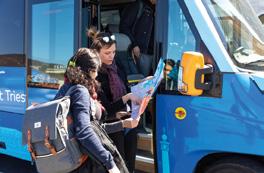
Professionalità ed entusiasmo al Centro Odontoiatrico Poropat —
Competence and passion at Poropat Dental Care Centre
Il golfo di Trieste è una straordinaria palestra per chi pratica gli sport del mare.

Lo sa bene il dottor Augusto Poropat, dentista e velista, che del sorriso ha fatto la sua missione e che del mare ha fatto la sua passione.
Il giovane medico, dopo la laurea in Odontoiatria e Protesi Dentale all’Ateneo triestino (110 e lode!, nel 2016) e la specializzazione in Chirurgia Orale (2019), da poco meno di un anno ha fondato il “suo” centro odontoiatrico: in via San Nicolò, 12, proprio nel cuore della città. Uno studio molto colorato e arredato con gusto, dove il mare, in forma di belle immagini alle pareti, è una presenza che allieta e rassicura.
Autore di svariate pubblicazioni scientifiche, il dottor Poropat è aggiornatissimo sulle evoluzioni della
materia e attentissimo alle innovazioni tecnologiche.
Gentile e cordiale, Poropat appartiene alla Rinomata Categoria delle Persone Sorridenti, così come tutto il suo staff. Incontrare gente che sorride fa bene a tutti. In uno studio dentistico ancora di più.
Il mare è una presenza importante nella vita di questo dentista-velista, che con l’Indigo Sailing team ha partecipato a più di 10 campionati di categoria ORC.
La prossima gara che lo aspetta è una competizione mitica: la “600 miglia tra le isole greche”. Appena può Augusto Poropat veleggia con una sua barca per godersi il piacere del mare di casa. E, naturalmente, non si perde mai una Barcolana! Non ne perde una da quando aveva 9 anni.
Ma ora torniamo a terra…
PROFILI IL SORRISO AL CENTRO
76 IES, TRIESTE LIFESTYLE N°21 — Summer 2023 Contributors
Come medico dentista il dottor Poropat segue in particolare l’aspetto della chirurgia e delle protesi, ma la sua équipe può contare anche sulla preziosa figura di Franca Tamaro, che parla con i pazienti e, soprattutto, sa ascoltarli, del dottor Alessandro Facchini e del dottor Dario Basile, per l’odontoiatria conservativa, della dottoressa Iuliia Kashtelianska, ortodontista, della dottoressa Kristina Boric, igienista, e di Oksana, Giulia, Svitlana, formidabili assistenti. Da bravo sportivo il giovane dentista ci tiene a progredire, a superarsi, per questo dedica una ricerca particolare verso le migliori apparecchiature oggi disponibili, come la TAC dentale, lo scanner computerizzato, le telecamere digitali ad alta definizione e tutte quelle soluzioni che semplificano la vita al paziente.
Già, perché prima che nella tecnologia, Augusto Poropat crede nell’aspetto umano del proprio lavoro, nell’importanza di fornire a ogni paziente la risposta più personale e precisa possibile, dalla prima visita in poi. Ovvero, dal primo colloquio “con Franca”: quattro chiacchiere per capire il percorso più indicato da intraprendere per ciascun paziente. Sportivo, entusiasta, instancabile, Poropat è professore a contratto presso la clinica universitaria odontoiatrica e stomatologica di Trieste, occupandosi della parte clinica e di ricerca nell’ambito della medicina e patologia orale. Perché tutti meritano di sorridere.
Informativa sanitaria ai sensi della legge n° 248 (04/08/2004) e legge n° 145 (30/12/2018). Direttore Sanitario dott.
Augusto Poropat - Albo Odontoiatri Trieste 470 - Centro Odontoiatrico Poropat.
ENGLISH TEXT
The Gulf of Trieste is an excellent training ground for water sport athletes and enthusiasts. One of them is dentist and yachtsman Dr Augusto Poropat, whose core mission is smile and whose passion is the sea.
After graduating summa cum laude in Dentistry and Dental Prosthodontics at the University of Trieste in 2016, and specialising in Oral Surgery in 2019, less than a year ago young Dr Poropat inaugurated “his own” Centro Odontoiatrico (i.e. Dental Care Centre) at no.12 Via San Nicolò, in the very heart of the city. Poropat’s clinic is tastefully furbished and full of colour, with relaxing views of the sea hanging from the walls to welcome and comfort patients.

Dr Poropat operates according to the latest technological innovations and state-of-the-art protocols of his field, and is featured among the authors of numerous scientific publications.
A kind and affable man, Dr Poropat is the type of person that others describe as “always having a smile on his face” –and so does his staff. A smiling face is a universal remedy, especially in a dental care clinic.
The sea plays a crucial role in the life of this dentist-sailor, who has participated in more than ten ORC championships as a member of the Indigo Sailing team.
His next race is a legendary regatta: Aegean 600, “a non-stop 600nm offshore race through iconic Greek
islands”. Augusto Poropat never misses a chance to set off on one of his boats and enjoy the Gulf waters. And, of course, he never misses a Barcolana! He has always raced in it since he was 9.
Time to head back to the dock and land…
In his clinic Dr Poropat is mainly in charge of oral surgery and prosthodontics. His team also includes Franca Tamaro at the front desk, in charge of welcoming, speaking with and, most importantly, listening to patients; Dr Alessandro Facchini and Dr Dario Basile, in charge of conservative dentistry; orthodontist Dr Iuliia Kashtelianska; dental hygienist Dr Kristina Boric; and brilliant assistants Oksana, Giulia, and Svitlana.
Displaying a true athlete’s mindset, Dr Poropat constantly strives to advance and improve, which is why he equipped his Centro with the best instruments technology has to offer, such as dental cone beam CT scan, high-definition digital cameras, and every other possible device that makes his patients’ lives easier.
Indeed, Augusto Poropat’s no.1 priority is the human dimension of his job: he believes in the importance of providing his patients with individualised, high-precision care, starting from the very first appointment. Which invariably starts with an interview “with Franca”: a brief chat to determine the best possible care plan for each patient.
Dynamic, passionate, tireless: Poropat also works with University of Trieste’s Dentistry and Oral Surgery Clinic, in the fields of both clinical practice and research in oral pathology and medicine studies. Because everyone deserves to smile.
Healthcare information and publicity material supplied in compliance with Law no. 248 (04/08/2004) and Law no. 145 (30/12/2018). Chief Medical Officer Dr Augusto Poropat - Albo Odontoiatri Trieste registration no. 470 - Centro Odontoiatrico Poropat.
Via S. Nicolò, 12, Trieste Tel. 040 064 1600
Cell. 375 512 7389
info@centroporopat.it
www.centroporopat.it
INFO
77 IES, TRIESTE LIFESTYLE N°21 — Summer 2023 Contributors
AQUILEIA
UNA RICCA ESTATE
NEL SITO UNESCO IMMERSO TRA NATURA E STORIA
A rich summer at the Unesco site surrounded by nature and history
L’archeologia al cinema sarà protagonista dal 1° all’8 agosto per la quattordicesima edizionedell’Aquileia Film Festival – rassegna di cinema archeologico organizzata dalla Fondazione Aquileia con Archeologia Viva e Firenze Archeofilm.
La piazza della maestosa basilica dei Patriarchi si trasformerà in un palcoscenico naturale sul quale si alterneranno documentari di produzioni internazionali che spazieranno dal mercato dei fossili di dinosauro ai mosaici sommersi di Baia, dal mistero dei geroglifici alle pitture rupestri della grotta Cosquer messe in pericolo dal cambiamento climatico.
Non mancherà lo spazio dedicato alle produzioni girate in Friuli Venezia Giulia e ai libri, tra cui la presentazione di “Aquileia una guida” insieme agli autori e protagonisti.
La serata di apertura sarà dedicata ai 25 anni del sito Unesco di Aquileia e alla via Appia, candidata Unesco; durante le 6 serate si alterneranno sul palco, nell’intervallo tra i film, direttori di musei nazionali e internazionali e grandi divulgatori (programma completo su www.fondazioneaquileia.it).
La musica sarà il filo conduttore dell’estate con la ricca stagione di concerti di musica sacra nella basilica di Aquileia dal 24 giugno al 16 settembre e grandi ospiti che si esibiranno a metà luglio sulla piazza della basilica
(programma completo su www.discoveraquileia.com).
Torna venerdì 11 e sabato 12 agosto Calici di Stelle, l’iniziativa organizzata dal Comune di Aquileia con il Consorzio DOC Friuli Aquileia e il Consorzio DOC-FVG che punta ad esaltare i sapori del vino del territorio.
Grande novità i “Venerdì d’estate” con l’apertura straordinaria serale fino alle 22:30 della basilica, del museo archeologico nazionale, del decumano di Aratria Galla, del sepolcreto, della domus di Tito Macro e della domus e palazzo episcopale.
Ogni venerdì, inoltre, grazie all’Archeobus, iniziativa del Consorzio Grado Turismo, gli ospiti di Grado potranno raggiungere Aquileia per partecipare a una visita guidata e a una degustazione enogastronomica (www.Grado.it).
Al Museo archeologico nazionale proseguirà l’iniziativa #domenicalmuseo (ogni prima domenica del mese ingresso gratuito) e gli ormai consueti appuntamenti musicali e teatrali e gli incontri con gli autori, in collaborazione con alcune importanti realtà del territorio.
In programma tutta l’estate le visite guidate organizzate da PromoTurismoFvg e le passeggiate teatralizzate per bambini e famiglie realizzate in collaborazione con Fondazione Radio Magica. (Programma completo su www.discoveraquileia.com)
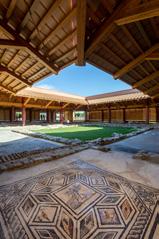
Buldrin 78 IES, TRIESTE LIFESTYLE N°21 — Summer 2023 Contributors
A.
Archaeology at the cinema will be the protagonist from 1 to 8 August for the fourteenth edition of the Aquileia Film Festival - an archaeological film festival organised by the Fondazione Aquileia with Archeologia Viva and Firenze Archeofilm. The square of the majestic basilica of the Patriarchs will be transformed into a natural stage on which documentaries of international productions will alternate, ranging from the dinosaur fossil market to the submerged mosaics of Baia, from the mystery of hieroglyphics to the rock paintings of the Cosquer cave endangered by climate change. There will also be space dedicated to productions filmed in Friuli Venezia Giulia and books, including the presentation of “Aquileia una guida” (Aquileia, a guide) together with the authors and protagonists.
The opening evening will be dedicated to the 25th anniversary of the Unesco site of Aquileia and to the Via Appia, a Unesco candidate; during the six evenings national and international museum directors and great popularisers will
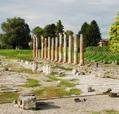

take turns on stage in the interval between the films (complete programme on www.fondazioneaquileia.it). Music will be the leitmotif of the summer with a rich season of concerts of sacred music in the basilica of Aquileia from 24 June to 16 September and great guests will perform in mid-July in the square of the basilica (complete programme on www.discoveraquileia.com). Calici di Stelle returns on Friday 11 and Saturday 12 August, the initiative organised by the Municipality of Aquileia with the Friuli Aquileia DOC Consortium and the DOC-FVG Consortium, which aims to enhance the flavours of the area’s wines.
A great novelty is the “Summer Fridays” with the extraordinary evening opening until 10.30 pm of the basilica, the national archaeological museum, the decumanus of Aratria Galla, the burial ground, the domus of Titus Macro and the domus and episcopal palace.
Furthermore, every Friday, thanks to the Archeobus, an initiative of the Consorzio Grado Turismo, guests in Grado will be able to reach Aquileia to take part in a guided tour and a wine and food tasting (www.Grado.it). At the National Archaeological Museum the #domenicalmuseo initiative will continue (free admission every first Sunday of the month), as well as the traditional musical and theatrical events and meetings with authors, in collaboration with some important local organisations. Guided tours organised by PromoTurismoFvg and theatralised walks for children and families organised in collaboration with Fondazione Radio Magica are scheduled throughout the summer. (Complete programme at www.discoveraquileia.com)
Podcast “Aquileia città frontiera”
On line dal 16 giugno su tutte le piattaforme la nuova serie podcast “Aquileia città frontiera” che racconta in 10 episodi 2.000 anni di glorie, speranze e cultura. Dieci date emblematiche per un viaggio indimenticabile dentro una città, attraverso le sue storie dalla storia.
Il podcast è stato realizzata grazie a un progetto della Fondazione Aquileia finanziato dalla legge 77/2006 dedicata ai siti Unesco e prodotta da Archeostorie e NWFactory.
On line from 16 June on all platforms is the new podcast series “Aquileia, a frontier city” which recounts 2000 years of glories, hopes and culture in 10 episodes. Ten emblematic dates for an unforgettable journey inside a city, through its stories from history. The podcast was produced thanks to a project of the Fondazione Aquileia financed by law 77/2006 dedicated to Unesco sites and produced by Archeostorie and NWFactory.
ENGLISH TEXT
–
N. Brollo 79 IES, TRIESTE LIFESTYLE N°21 — Summer 2023 Contributors
IN RIFUGIO C’È PIÙ GUSTO FUORI PORTA
Food tastes better on the mountain hut
Le montagne del Friuli Venezia Giulia si preparano ad ospitare le aziende che producono prodotti di eccellenza: dal 24 giugno al 29 luglio sei appuntamenti in alta quota dove si potrà degustare pietanze, incontrare i produttori e partecipare ai laboratori gratuiti adatti a tutti, adulti e bambini, trascorrendo una giornata in famiglia o in compagnia in mezzo alla natura incontaminata.

La rassegna, organizzata da PromoTurismoFVG, Agrifood FVG e Assorifugi, vuole portare in risalto i tanti prodotti offerti dal territorio presentandoli in un contesto unico come quello montano che in estate propone già un panorama ampio di attività da vivere all’aria aperta, dall’escursionismo al bike, al canyoning.
Il 24 giugno si inizia con La Gubana della Nonna di Azzida: al rifugio Pian dei ciclamini, nella Alta Val Torre a Lusevera, bambini e adulti si sono cimentati in cucina provando a realizzare il dolce tipico delle Valli del Natisone.
Il 1° luglio a Sappada, al rifugio Piani del Cristo, il cioccolato della Pasticceria Mosaico - Cocambo di Aquileia è stato il re della giornata.
Sabato 8 luglio ai piedi del monte Cogliàns, la vetta più elevata del Friuli Venezia Giulia (2.780 metri), Martina e Mattia, gestori del rifugio Tolazzi, insieme a Consuelo e Matteo dell’azienda Che Lumaca di Colloredo di Montalbano sono pronti a sorprendere con un menù singolare, a base di lumache. Durante la giornata, dalle 11 alle 15, si può infatti partecipare al laboratorio gratuito per scoprire il mondo delle chiocciole e liberare l’estro creativo
N. Brollo 80 IES, TRIESTE LIFESTYLE N°21 — Summer 2023 Fuori porta
Laboratori gratuiti per adulti e bambini alla scoperta dei prodotti “Io sono FVG”
Free workshops for adults and children to discover the products of “I am FVG”
“giocando” con i loro gusci.
Il 15 luglio, al rifugio Fornas, non lontano da Tolmezzo in cui è possibile visitare il Museo Carnico delle Arti Popolari
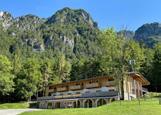
“Michele Gortani”, uno dei musei etnografici di area alpina più importanti d’Europa, si potrà assaporare alcune pietanze arricchite dallo zafferano, l’oro rosso prodotto dall’azienda Aurora
Azzurra Gregorutti di Majano. Grandi e piccoli potranno creare anche un fiore di zafferano in mosaico per una giornata all’insegna del divertimento e del gusto.
Sabato 22 luglio si torna alle pendici del monte Cogliàns: al rifugio Chiampizzulon. Federico e Debora, gestori del rifugio, e Jessica di Lycia Apicoltura, prepareranno un piatto ad hoc dove il miele, conosciuto come il nettare degli dèi, è protagonista. Un penultimo appuntamento dove si potrà conoscere l’importante mondo delle api attraverso una mini-lezione didattica e un laboratorio per realizzare candele di cera.

Il paesaggio delle Prealpi Carniche fa da sfondo al sesto e ultimo appuntamento di sabato 29 luglio; al Rifugio Valinis di Meduno, punto di partenza per escursioni di varie difficoltà nonché poco distante dall’area decollo deltaplano, Bernardo, gestore del rifugio, e Gianni dell’azienda Carpenedo proporranno dei piatti realizzati con la cipolla rossa di Cavasso Nuovo, un prodotto Slow Food dalla dolcezza unica.
Ma la montagna del Friuli Venezia Giulia si può vivere tutta l’estate: sarà possibile raggiungere le tante vette percorrendo sentieri escursionistici immersi tra i boschi o utilizzando gli impianti di risalita: a Forni di Sopra le Seggiovie
Varmost 1 e 2 saranno aperte tutti i giorni dall’8 luglio al 3 settembre; la telecabina del Lussari, nel Tarvisiano, oltre alle aperture giornaliere previste fino al 17 settembre e durante i weekend fino al 1° ottobre, sarà aperta tutti i venerdì di agosto, in notturna, fino alle 23; a Sella Nevea la Telecabina Canin sarà fruibile tutti i giorni dall’8 luglio al 10 settembre; a Piancavallo la Seggiovia Tremol 1 e il Bob su rotaia saranno agibili tutti i giorni dall’8 luglio fino al 3 settembre, così come gli impianti di Sappada e dello Zoncolan.
81 IES, TRIESTE LIFESTYLE N°21 — Summer 2023 Outside the city
N. Brollo
The mountains of Friuli Venezia Giulia are getting ready to host the firms that produce products of excellence: from 24 June to 29 July, six appointments at high altitude where you can taste dishes, meet the producers and participate in free workshops suitable for everyone, adults and children, spending a day with the family or in company in the midst of unspoilt nature. The event, organised by PromoTurismoFVG, Agrifood FVG and Assorifugi, aims to highlight the many products offered by the area, presenting them in a unique context such as the mountains, which in summer already offer a wide range of outdoor activities, from hiking to biking and canyoning. On 24 June, the event kicked off with La Gubana della Nonna in Azzida: at the Pian dei Ciclamini hut, in the Alta Val Torre in Lusevera, children and adults tried their hand at cooking the typical dessert of the Natisone Valleys. On 1 July in Sappada, at the Piani del Cristo hut, chocolate from the Pasticceria Mosaico - Cocambo di Aquileia was king of the day. On Saturday 8 July, at the foot of Mount Cogliàns, the highest peak in Friuli Venezia Giulia (2,780 metres), Martina and Mattia, managers of the Tolazzi refuge, together with Consuelo and Matteo of the Che Lumaca firm from Colloredo di Montalbano, are ready to surprise with a unique menu based on snails. During the day, from 11 a.m. to 3 p.m., you can take part in a free workshop to discover the world of snails and unleash your creative flair by “playing” with their shells.


Michele Gortani” Carnic Museum of Popular Arts, one of the most important ethnographic museums in the Alpine area in Europe, you will be able to taste some dishes flavoured with saffron, the red gold produced by the Aurora Azzurra Gregorutti company in Majano. Young and old alike will also be able to create a saffron flower mosaic for a day of fun and taste. Saturday, 22 July, we return to the slopes of Mount Cogliàns: to the Chiampizzulon
hut. Federico and Debora, managers of the refuge, and Jessica of Lycia Apicoltura, will prepare a special dish where honey, known as the nectar of the gods, is the protagonist. The landscape of the Carnic Pre-Alps provides the backdrop for the sixth and final event on Saturday 29 July; at the Valinis Refuge in Meduno, the starting point for hikes of varying difficulty and not far from the hang-gliding take-off area, Bernardo, who runs the hut, and Gianni from the Carpenedo company will prepare dishes using the red onion of Cavasso Nuovo, a Slow Food product with a unique sweetness. But the mountains of Friuli Venezia Giulia can be experienced throughout the summer: it will be possible to reach the many peaks along hiking trails immersed in the woods or using the ski lifts: in Forni di Sopra, the Varmost 1 and 2 chairlifts will be open every day from 8 July to 3 September; the Lussari cableway, in the Tarvisio area, in addition to the daily openings scheduled until 17 September and at weekends until 1 October, will be open every Friday in August, at night, until 11pm; in Sella Nevea, the Canin cableway will be open every day from 8 July to 10 September; in Piancavallo, the Tremol 1 chairlift and the Bob on Rail will be open every day from 8 July to 3 September, as will the Sappada and Zoncolan lifts.
ENGLISH TEXT
82 IES, TRIESTE LIFESTYLE N°21 — Summer 2023 Fuori porta
N. Brollo


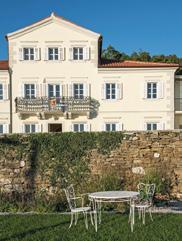
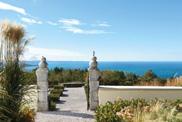
Villa Bonomo • info@villabonomo.it • villabonomo.it • +39 338 291 6593
Tarvisio e la sua foresta sono meta ideale per una full immersion nella natura; territori incontaminati dove trascorrere una giornata o una vacanza all’insegna del relax, dei ritmi lenti, ma anche dello sport e del movimento che si coniugano con accoglienti strutture ricettive, tutte family friendly.
L’offerta dedicata alle famiglie spazia dal parco giochi, al bob a rotaia; dal bike e mountain bike dai tracciati semplici, senza dislivello, a quelli più impegnativi, attrezzati per soste/picnic e facilmente raggiungibili.

A Camporosso, poco distante dalla chiesa principale di Via Duomo (possibilità di parcheggio) parte il “Sentiero degli gnomi”, tracciato facile, a mezzo bosco, che percorre parte del crinale. Ad accoglierci uno strano ma divertente gnomo in legno e un cartello che invita a proseguire e scovare altri gnomi per scoprire caratteristiche e abitudini di questi abitanti del bosco. Attenzione però bisogna procedere rispettando la natura! Il tracciato non è percorribile con i passeggini.
I Bergmännchen sono, invece, gli gnomi che abitano a Tarvisio. Percorrendo il “Weidachweg”, sentiero che costeggia il torrente Bartolo –partenza dietro l’Hotel Edelhof, fino a via del Torrente–, si scoprono tante curiosità su
IN UN MARE DI VERDE
Diving into a sea of green
di loro, sulla loro vita, sull’ambiente circostante. Il tracciato è arricchito da cartelli didattici, giochi e da una simpatica area attrezzata, un villaggio in miniatura dove c’è anche un punto per fare dei selfie e… chissà mai che uno gnomo non appaia nella foto?! Presso l’InfoPoint di Tarvisio è disponibile un simpatico kit gratuito per i bambini.
Per i più grandicelli c’è lo Skate Park (in via degli Azzurri) e il vicino “Lynx Trail”: si tratta di un percorso naturalistico didattico dedicato alla lince, il più raro dei mammiferi in Italia, a rischio estinzione, che vive nella foresta di Tarvisio. La salita nel bosco, semplice e piacevole, porta a due punti panoramici; lungo il sentiero, le bacheche didattiche danno numerose informazioni su questo felino, difficile da vedere in natura. Si consigliano calzature da trekking.
IMMERGERSI
TARVISIO C. Spaliviero 84 IES, TRIESTE LIFESTYLE N°21 — Summer 2023 Contributors
Attività in gruppo per bambini e ragazzi Group activities for children and teens
Tarvisio offre la possibilità ai ragazzi tra i 3 e i 16 anni di fare sport vivendo il territorio. Durante le giornate di frequenza gli educatori organizzano attività sportive e ludiche all’aperto, escursioni con esperienze sensoriali, psicomotorie ed educative.

Tarvisio offers numerous ways of discovering its territory through sport activities dedicated to young guests from 3 to 16 years of age. Organised day trips include outdoor exercise and games, and itineraries through sensory, psychomotor, and educational experiences under the supervision of trained educators.
Info
Associazione culturale La Cordata www.lacordata.eu
US Camporosso
www.uscamporosso.it
–
C. Spaliviero 85 IES, TRIESTE LIFESTYLE N°21 — Summer 2023 Contributors
Card
Chi soggiorna nelle strutture, avrà la + Card Holiday che dà diritto a sconti o gratuità in musei, impianti di risalita, laboratori e altre attività (alcune anche in Austria e Slovenia) nonché alle escursioni organizzate da Promoturismo FVG.
La FVGcardTarvisiano ForestCampCard invece è acquistabile da tutti per 3 o 7 giorni e per beneficiare altrettanto di sconti e gratuità.


Guests of local approved accommodations are entitled to + Card Holiday, which provides free access and/ or reduced entrance fees to museums, ski lifts, workshops, and more (including activities taking place in neighbouring Austria and Slovenia), as well as participation in PromoturismoFVG’s organised trips.

The forests of Tarvisio are the ideal destination for a full-immersion experience in nature: an unspoilt environment for an outof-town daytrip or a full-fledged holiday of complete relaxation in one of the numerous family-friendly accommodation options in the area. Here you can enjoy the cosy rhythm of slow lifestyle or choose from a wide array of sports and outdoor activities.
Family vacation activities include fully equipped playgrounds; rail coasters; and bike- and mountain-bike trails of various difficulty levels, ranging from flat cycle paths to more challenging itineraries, all easily accessible and outfitted with rest/picnic areas.
Camporosso, near the main church located in Via Duomo (parking area nearby), is the starting point of the «Gnomes’ trail»: an easy walking itinerary following part of the mountain ridge through wooded areas. A funny-looking wooden gnome welcomes visitors and signals the entrance of the
trail, where a signpost invites you to proceed and spot other gnomes along the way, to learn about the traits and habits of these peculiar wood dwellers. Those who enter the trail must respect nature! Strollers are not allowed.
Tarvisio gnomes are known as Bergmännchen. Behind Edelhof Hotel, and following Via del Torrente, visitors will find the entrance of the «Weidachweg», a trail running along Bartolo creek: along this itinerary you can find out all about Bergmännchen, their way of life, and the surrounding environment. Weidachweg is complete with detailed educational signage, as well as games, a rest area, a miniature village with a selfie point, and… who knows, maybe even a gnome or two that will pop up in one of your pictures! Free trail kits for children are available at Tarvisio InfoPoint.
Those who have outgrown gnomes and fairy tales will certainly enjoy the Skate Park (located in Via degli Azzurri) and the nearby «Lynx Trail»: an educational nature trail focusing on the lynx, the bobcat dwelling in the forests of Tarvisio, which is Italy’s oldest mammal and currently an endangered species. The gentle climb through the wood leads to two panoramic viewpoints. Informational signage guides visitors throughout the whole itinerary, providing interesting insight into this feline species, so hard to spot in the wild. Hiking shoes recommended.
–
ENGLISH TEXT
86 IES, TRIESTE LIFESTYLE N°21 — Summer 2023 Contributors
In rifugio c’è più gusto!
UN’INIZIATIVA PER FAMIGLIE TRA LE MONTAGNE DELLA NOSTRA REGIONE.
Quest’estate scopri il gusto autentico della sostenibilità con la tua famiglia, tra gli ingredienti e i prodotti a marchio
IO SONO FRIULI VENEZIA GIULIA e nei rifugi montani che fanno parte di Assorifugi. IO SONO FRIULI VENEZIA GIULIA e Assorifugi sono due realtà quotidianamente impegnate nella tutela del nostro territorio, con i suoi prodotti, le sue persone, le sue meraviglie naturali.

Affamato di sostenibilità? Scopri i prodotti
IO SONO FRIULI VENEZIA GIULIA su www.iosonofvg.it

SCOPRI DI PIÙ SU IN RIFUGIO
 C’È PIÙ GUSTO!
C’È PIÙ GUSTO!
Pedalare nel cuore delle Alpi Giulie
In sella a una mountain bike o ad una bici da strada, da soli, in gruppo o in famiglia, la scelta dei percorsi è vasta per sportivi di ogni livello.
Prima tra tutte la Ciclovia Alpe Adria, la grande via ciclabile che collega Salisburgo a Grado. Accessibile da più punti, dalle sue diramazioni è possibile raggiungere i luoghi più caratteristici del territorio, i laghi di Fusine, il confine con l’Austria o la Slovenia.
Solcano boschi, costeggiano torrenti, laghi o radure, prati e pascoli, i tracciati percorribili con la mountain bike sono davvero tantissimi; molti dei quali indicati in una mappa reperibile presso l’info point di Tarvisio. Da Tarvisio si raggiungono agevolmente vette e rifugi e si costeggiano laghi con bellissimi scorci, pedalando in luoghi incontaminati.
Dedicato alle mountain bike è il “bike park della piana dell’Angelo” (vedi IES n.20).
La salita al Monte Lussari, percorso della recente Tappa del Giro d’Italia, è accessibile dalla Val Saisera, percorribile esclusivamente in salita, è adatta a ciclisti molto esperti. Per quanto riguarda l’ospitalità Tarvisio è bike friendly; quasi tutte le strutture ricettive sono organizzate per ospitare i ciclisti e rispondere alle loro esigenze; i noleggi, sia di biciclette muscolari che elettriche, sono parecchi e ben distribuiti sul territorio ed alcuni offrono anche la possibilità di avere delle lezioni private o individuali.
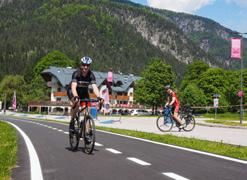
Eccone alcuni: Lussari Sport in Via Lussari, 20, a Camporosso; Baldan Sport in Via Roma; Alpgrent Ski e Bike in via Priesnig; Rent A Ski & Bike
Valle Verde, in via Priesnig, 52.
Cycling in the heart of the Julian Alps
Riding a mountain bike or a road bike, alone, in a group or with the family, the choice of routes is vast for athletes of all levels. First and foremost is the Alpe Adria Cycle Route, the great cycle route connecting Salzburg and Grado. Accessible from several points, through its branch routes you can reach the most characteristic places in the area, the Fusine lakes, the Austrian border or Slovenia. Crossing woods, skirting streams, lakes or clearings, meadows and pastures, the tracks that can be travelled by mountain bike are countless; many of them are marked on a map that can be found at the Tarvisio info point. From Tarvisio you can easily reach peaks and mountain huts and ride along lakes with beautiful views, pedalling through unspoilt nature. Dedicated to mountain bikes is the “Piana dell’Angelo bike park” (see IES no. 20). The climb to Mount Lussari, the route of the recent stage of the Giro d’Italia, is accessible from Val Saisera, and can only be cycled uphill; it is suitable for very experienced cyclists. As far as hospitality is concerned, Tarvisio is bike friendly; almost all accommodation facilities are organised to host cyclists and respond to their needs; there are many rentals, both muscle and electric bicycles, well distributed throughout the territory, and some also offer the possibility of private or individual lessons. Here are a few: Lussari Sport in Via Lussari, 20, in Camporosso; Baldan Sport in Via Roma; Alpgrent Ski and Bike in Via Priesnig; Rent A Ski & Bike Valle Verde, in Via Priesnig, 52.
App Tarvisio
Tarvisio è un’app ricca di informazioni. Si possono trovare, corredate da numerose immagini, notizie storiche, punti di interesse con geolocalizzazione, tradizioni, nonché eventi, itinerari per escursioni e passeggiate, curiosità e webcam. Disponibile per iOS e Android. –
Tarvisio app is an infinite source of information: watch and read about history, landmarks (with geotracking), traditions, but also upcoming and ongoing events, trails and itineraries, interesting facts… there is even an in-built link-up to the app webcam. Available for iOS and Android.

C. Spaliviero 88 IES, TRIESTE LIFESTYLE N°21 — Summer 2023 Fuori porta












 di /by Giovanni Marzini
di /by Giovanni Marzini






















 di /by Rino Lombardi
di /by Rino Lombardi


















 Foto e testo di/Photo and text by Fabio Parenzan
Foto e testo di/Photo and text by Fabio Parenzan

 A sinistra /Left Andreina Contessa, direttrice del Museo storico e il Parco del Castello di Miramare. Andreina Contessa, director of the Miramare Castle.
A sinistra /Left Andreina Contessa, direttrice del Museo storico e il Parco del Castello di Miramare. Andreina Contessa, director of the Miramare Castle.





























 Lorenzo Michelli
Lorenzo Michelli





















 The Happy feet Club, Via Mazzini 53.
The Happy feet Club, Via Mazzini 53.










































